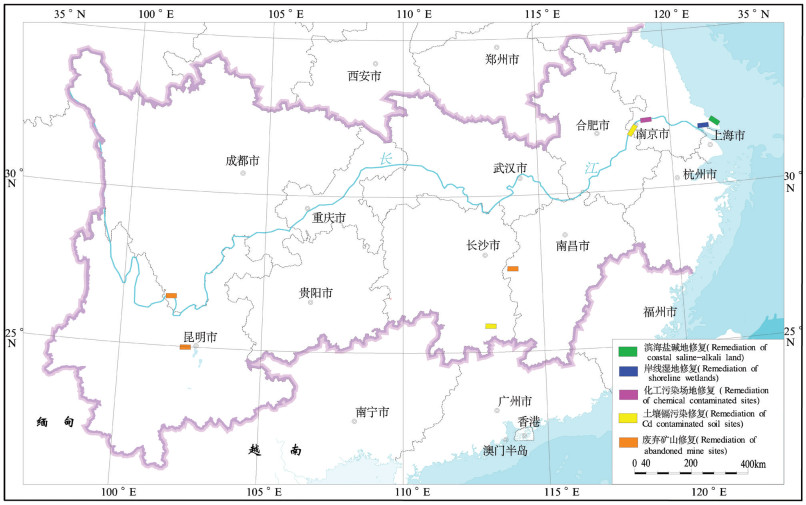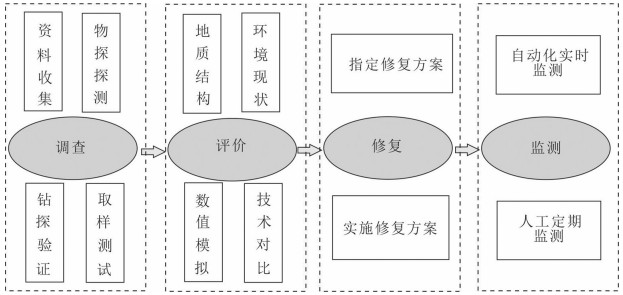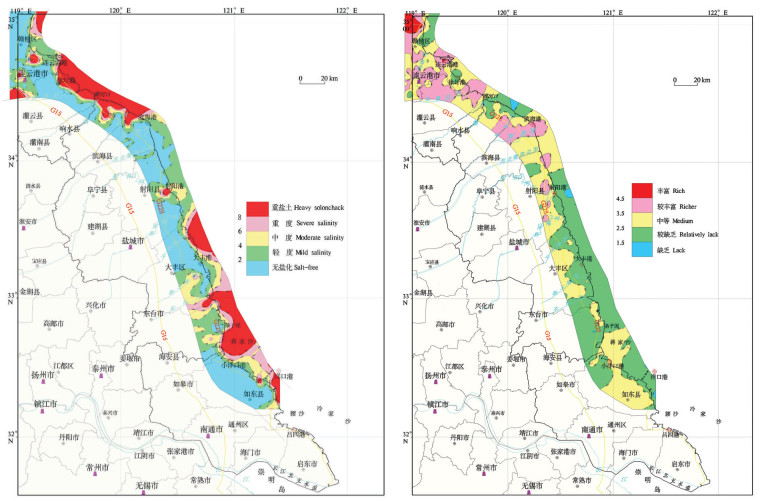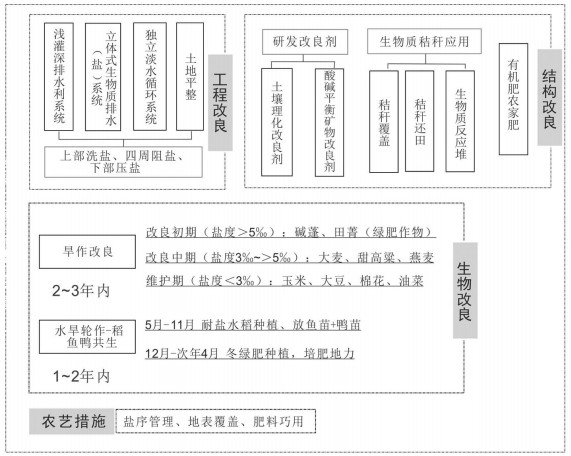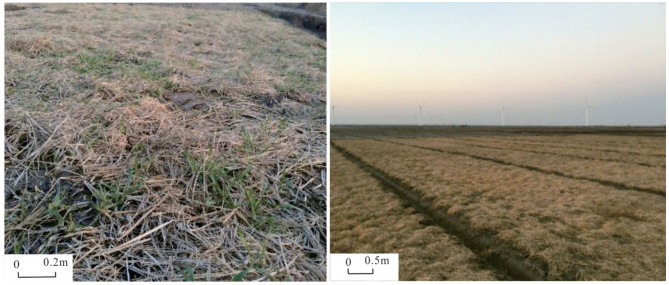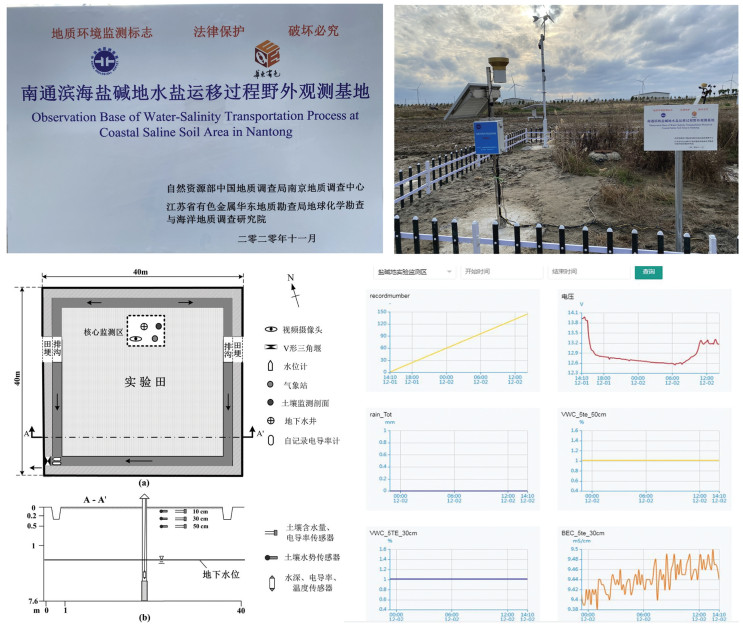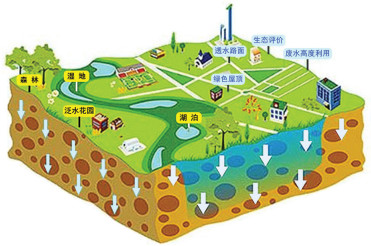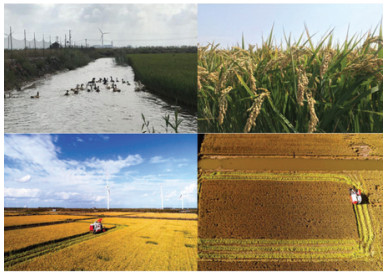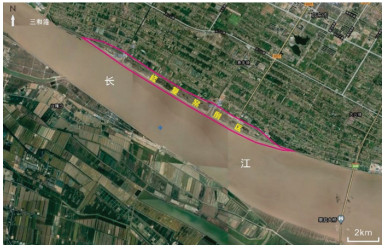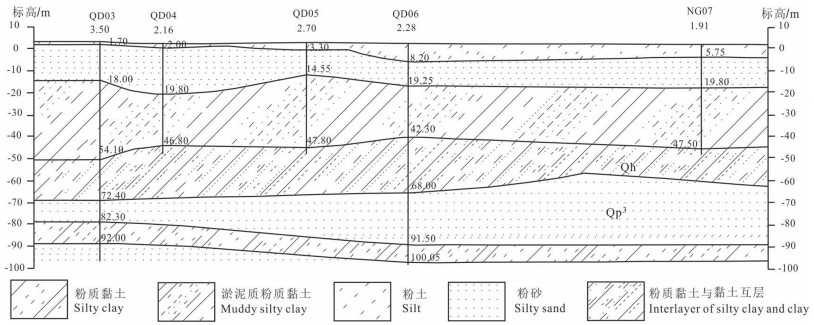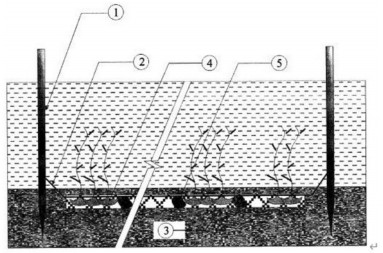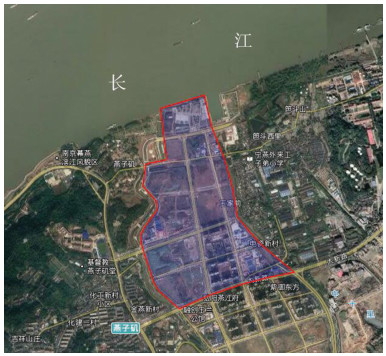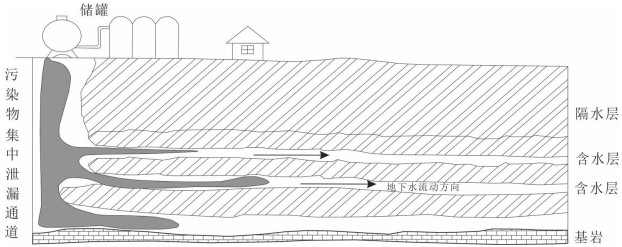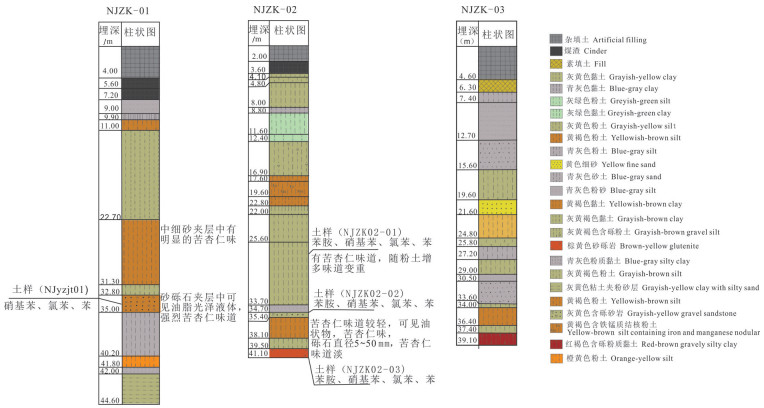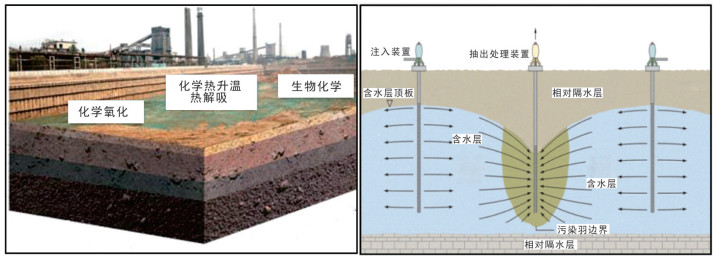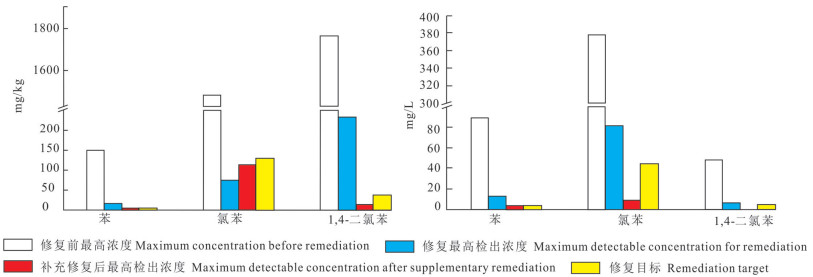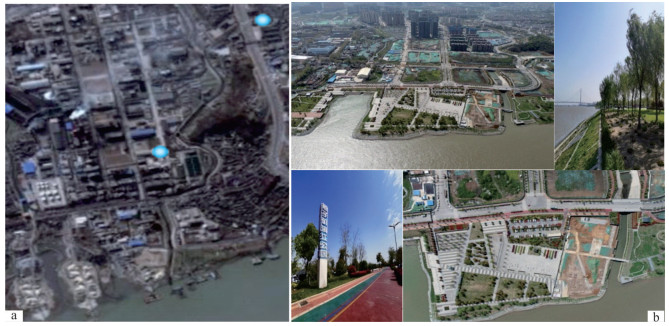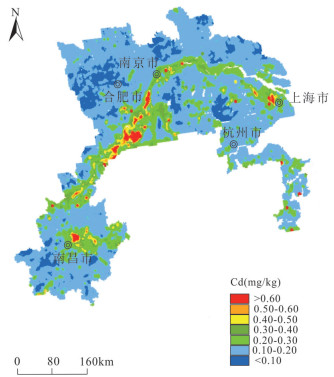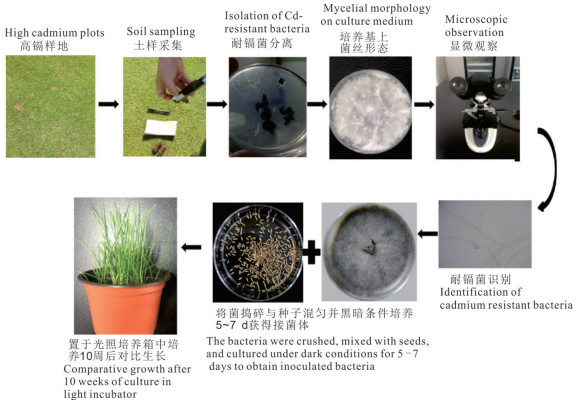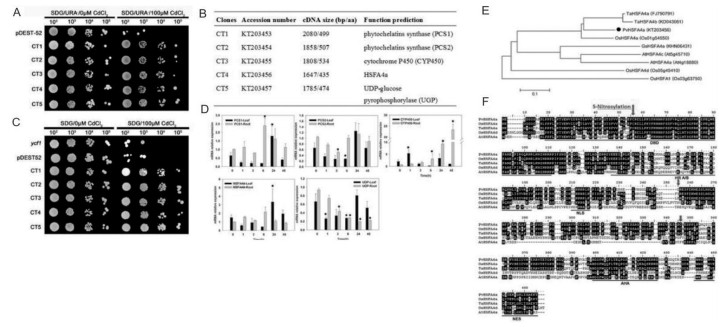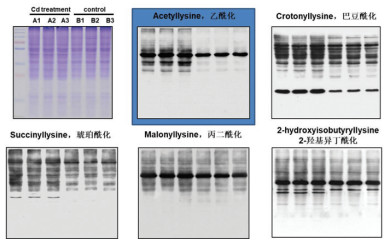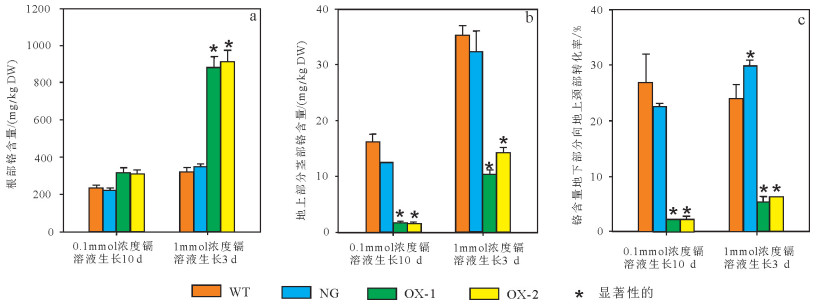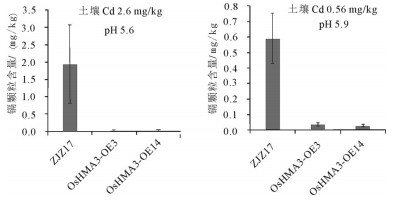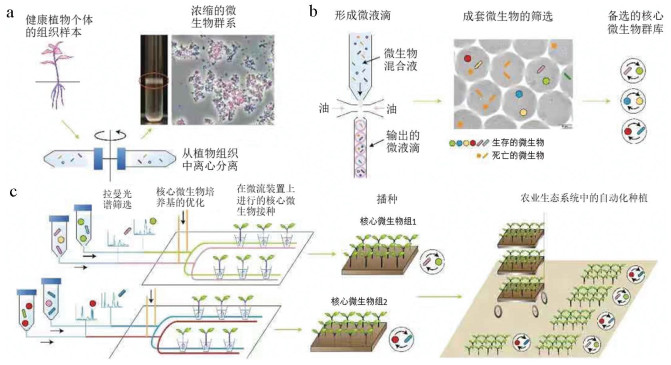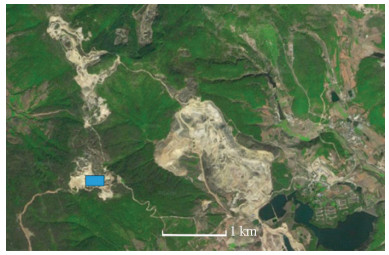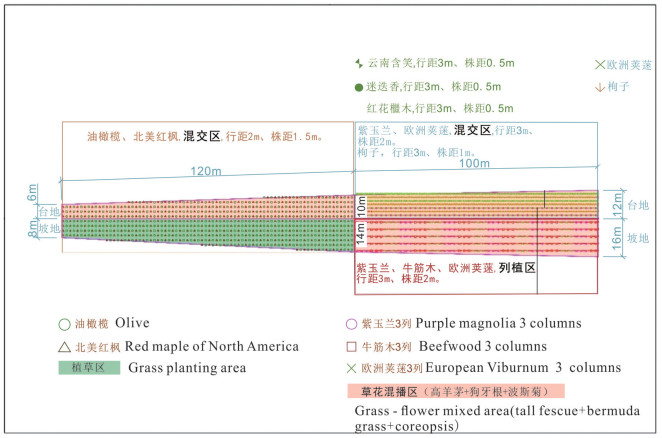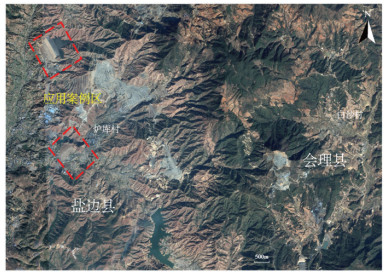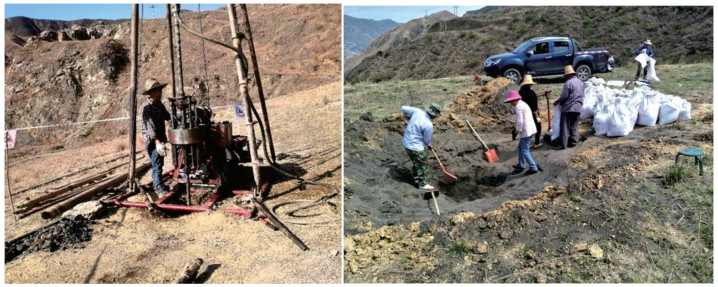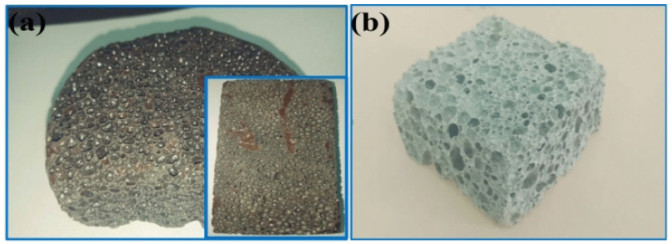Key technology of ecological restoration demonstration in the Yangtze River Economic Zone and its application
-
摘要:
围绕长江大保护,笔者近年探索形成滨海盐碱地、长江滨岸湿地、沿江化工污染场地、重金属污染场地和废弃矿山等5种类型生态修复示范关键技术,取得重要进展和应用成效:(1)探索形成南通滨海盐碱地"工程、结构、生物和农艺改良"等关键技术体系,建立了盐碱地水-盐运移环境实时动态监测体系,实现海水稻、玉米和油菜等系列农产品产业化,有效服务沿海地区盐碱地优质利用与国土空间规划。(2)提出江苏启东长江沿江湿地"生境优化、植物优选、多样性调控"综合生态修复技术,形成湿地休闲观光区、湿地生物多样性保护区和湿地尾水深度净化区等三大生态功能区,修复成果取得较好生态与社会效益。(3)创新有机污染探测技术,查明某典型化工园区地下"隐性"污染,精确圈定主要污染物深度,明确以硝基苯、苯、苯胺等为主的污染物类型,提出了污染修复深化建议,得到当地市政府、环保部门采纳建议方案,有效支撑服务有机化工废弃场地再开发。(4)研发耐镉转基因特有植物材料与高效修复功能微生物,探索形成沿江高镉土壤微生物-植物互作修复模式,为下一步微生物改良剂研制和规模化修复奠定重要基础。(5)形成云南安宁磷矿尾矿堆场生态修复和四川攀枝花钒钛磁铁矿尾矿资源化、减量化利用关键技术,有力支撑废弃矿山生态保护修复和尾矿资源化利用。
Abstract:The key demonstration technology for ecological restoration of five types of ecological environments was explored to protect ecological environment of the Yangtze River, including coastal saline-alkali land, coastal wetland of the Yangtze River, chemical pollution sites along the Yangtze River, heavy metal pollution sites and abandoned mines. Through the construction of "engineering, structure, biology and agronomic improvement" and other key technology systems of coastal saline-alkali land, the real-time dynamic monitoring system of water-salt migration environment in coastal saline-alkali land has been established, and the industrialization of a series of agricultural products such as sea rice, corn and canola has been realized, which effectively serve the high-quality utilization and territorial space planning of coastal saline-alkali land. The comprehensive ecological restoration technology of "habitat optimization, plant selection and diversity control" was proposed for the wetlands along the Yangtze River in Qidong, Jiangsu Province. Three ecological function areas, namely wetland leisure and sightseeing area, wetland biodiversity protection area and wetland tailwater deep purification area, were formed. The restoration results achieved good ecological and social benefits. Some progress and results have been made, including innovation of organic pollution detection technology, identification of underground "hidden" pollution of one typical chemical park, accurate delineation of main pollutants depth, and clarification of aniline nitrobenzene and benzene. The proposed suggestions on deepening pollution remediation have been adopted by the local municipal government and environmental protection departments to effectively support and serve the redevelopment of abandoned organic chemical sites. Develop cadmium-resistant transgenic specific plant materials and highly effective remediation microorganisms were developed to explore the formation of a microbial-plant interaction remediation mode in high-cadmium soil along the Yangtze River, which lay an important foundation for the development of microbial amendments and large-scale remediation in the future. The developed key technologies for ecological restoration of Anning phosphate tailings storage yard in Yunnan and resource utilization and reduction of vanadium titanomagnetite tailings in Panzhihua of Sichuan strongly support ecological protection and restoration of abandoned mines and resource utilization of tailings.
-
1. 引言
长江经济带横跨中国东中西三大地势阶梯,覆盖上海、江苏、浙江、安徽、江西、湖北、湖南、四川、重庆、云南、贵州等11个省(市),面积约205.3万km2,占全国陆域面积21.4%。长江经济带在中国经济发展中具有重要的战略地位,也是中国重要的生态安全屏障。改革开放40多年来,区域经济社会发展成就显著,但与此同时,生态环境也遭到了严重的破坏,生态环境形势严峻,特别是化工围江造成水土污染问题、上游重大水利工程建设导致中下游地区岸滩和河槽侵蚀问题、大规模矿业活动导致矿山环境问题、城镇化过度发展侵占湿地、岸线和保护区等(姜月华等, 2017, 2019)。为加强长江经济带生态环境保护,国家先后出台了《长江经济带发展规划纲要》(国务院,2014)、《长江经济带生态环境保护规划》(中国共产党中央委员会,2016)等相关文件,对长江经济带的环境保护和发展进行了战略布局和宏观设计。习近平总书记在推动长江经济带发展的重庆座谈会上鲜明指出,“推动长江经济带发展必须坚持生态优先、绿色发展,要把修复长江生态环境摆在压倒性位置,共抓大保护,不搞大开发”。显然,长江经济带生态环境保护和修复是当前及今后一段时间内急需开展的重要工作。为助力打好长江保护修复攻坚战,推动长江经济带高质量发展,中国地质调查局部署实施的“长江经济带地质环境综合调查工程”近年有针对性地开展了环境调查评价与生态修复示范。本文重点围绕滨海盐碱地、沿江湿地、有机化工污染场地和镉污染场地以及矿山尾矿等5种类型生态修复示范,阐述在调查和修复过程中探索形成的相关关键技术与取得的应用成效,以期为长江经济带生态保护修复和国土空间规划提供科学依据。
2. 地质背景
长江经济带地势西高东低,地貌与地质情况复杂。长江经济带可划分出东部低山平原、东南低—中山地、西南中高山地和青藏高原4个地貌区。从空间分布来看,大致以十堰—邵阳一线为界,西部主要为山地地貌、东部主要为平原台地地貌(图 1)。西部大致以广元—丽江一线为界,以西主要为极高山-高山地貌,以东主要为中山地貌。东部地区大致以邵阳—南京一线为界,以南以低山地貌为主,以北以平原为主间夹台地地貌。
长江经济带地层发育齐全,自太古宇至新生界第四系均有出露。长江经济带在大地构造上,主体部分为北北东方向分布的稳定地块——扬子陆块,在其四周为一系列活动性强的造山系围限,西缘为羌塘—三江造山系,北缘为华北陆块(南缘)、秦—祁—昆造山系(东段),南缘为江绍—萍乡—郴州对接带和华夏造山系。各陆块和造山系沉积环境、岩浆作用、变质作用和构造作用均各不相同(尹赞勳,1936;郭文魁,1942;江苏省地质矿产局,1989;黄慧珍等,1996;姜月华等,2015)。
长江经济带地质构造演化历史复杂(舒良树,2012;张国伟等,2013),太古宙至古元古代为陆块基底形成时期,中元古代—新元古代中期为超大陆裂解→三大洋形成发展→大陆边缘多岛弧盆系形成→转化为造山系,新元古代晚期—中三叠世为华北和扬子等陆块陆缘增生及其彼此之间聚合时期,晚三叠世以来主要受到西南印度板块与欧亚板块陆陆碰撞造山导致的青藏高原物质向东挤出和东部太平洋板块向西俯冲的双重影响(吴中海等,2016;孙玉军等,2016)。
长江经济带水文地质和工程地质条件复杂。地下水类型较全,包括孔隙水、岩溶水、裂隙水和孔隙裂隙水等。碎屑岩类裂隙-孔隙水主要分布于四川盆地,基岩裂隙水分布于广大丘陵山区,岩溶裂隙溶洞水主要分布于西部的云贵高原,松散岩类孔隙潜水及承压水主要分布于长江三角洲平原、鄱阳湖平原及江汉和洞庭湖平原的第四系含水层中。岩土体按介质和结构特征划分,主要有完整坚硬的基岩类、半胶结的岩类、松散土类以及特殊土等。
长江经济带地貌、地质构造、水文地质和工程地质条件复杂多变且上中下游差异显著,因此,导致水土污染、岸线侵淤、湿地退化、矿山地质环境破坏、区域活动断裂、滑坡崩塌泥石流灾害、岩溶塌陷和地面沉降等重大地质问题也呈现不同的分布特征❶❷❸❹❺❻(姜月华等,2017;Jiang et al., 2018;姜月华等,2019;程和琴和姜月华,2021;姜月华等,2021)。
3. 研究方法
生态修复按不同尺度的对象可以划分出流域、区域和场地规模的修复,本文涉及的滨海盐碱地、沿江湿地、有机化工污染场地和镉污染场地以及矿山尾矿等5种类型生态修复示范(图 2)均属场地级规模,工作流程主要分调查、评价、修复和监测4部分(图 3)。
其中,调查主要采用遥感、物探、化探、钻探等技术手段,重点查明修复区水文、工程和环境地质条件并进行生态问题识别与诊断。评价主要根据调查取得的资料对修复区的水土环境质量、生态系统状况、地质体结构和主要物质组分迁移转化等进行评价分析。修复是在调查和评价基础上提出修复目标和具体修复技术方案并开展修复工程。监测是在修复过程及修复后开展的自动实时或人工监测并进行科学评估。根据不同的修复对象和地质环境条件,修复技术十分重要,其直接决定修复效果,本次工作中探索了5种类型生态修复示范关键技术,旨在为相同类型的生态修复提供借鉴和参考。
4. 研究结果和讨论
4.1 滨海盐碱地改良修复示范
长江三角洲地区盐碱地特别是江苏沿海因拥有宽广的潮间带,长期以来经过人工不断围垦,形成了大面积的盐碱地。盐碱地修复在国内外一直引起很多学者关注,尤其是在盐碱地改良修复(牛东玲和王启基,2002;丁绍武和张鹏,2019)、水盐运移(Fageris et al., 1981;Stein et al., 2019;程知言等,2020)、生物群落变化(陈小雪等,2020)和成效(魏征等,2019;付力成等,2020)等方面。盐碱地在长江三角洲地区特别是江苏沿海因拥有宽广的潮间带,盐碱滩涂面积近6667 km2,约占全国沿海盐碱滩涂面积三分之一。为增加耕地占补平衡指标,加快盐碱地改良修复意义十分重大。
4.1.1 修复区域与生态问题
修复区位于江苏省南通市如东县东凌镇,2019—2020年修复面积约4万m2。区域原为沿海滩涂,20世纪70年代实施围海吹填工程后形成围垦区。20世纪90年代以来,区域逐渐变更为海水养殖产业基地。现全区正在开展土地复垦和整治修复工作,逐步转型为生态农业种植试验区。
盐碱地涉及的生态问题主要是土壤盐度高、肥力低与生态环境脆弱。调查显示,江苏沿海人工围垦区内土壤盐碱化问题严重(图 4),表层土壤平均盐度26‰,最高达42‰,属重盐土,土壤易板结。依据土壤全氮、有效磷、速效钾和有机质四项指标综合评价江苏沿海地区表层土壤养分表明总体土壤肥力低,属较缺乏—缺乏水平(图 4)。区域土壤基本具高盐、低肥特征,仅有沿海赤碱蓬、芦苇等原生植物可以存活,生态环境极其脆弱。修复区范围内的盐碱地形成机制与含盐量极高的浅埋地下水、土壤岩性、强蒸散发能力及局部微地形等因素密切相关。该地区地下50 m以浅地层岩性主要为粉土、粉砂。地表土壤多为粉土和粉质黏土。该类土壤毛细管作用强烈,地下水易向上运移,加之地下水埋深浅(年内平均埋深仅1m左右)、盐度极高(超过海水),地下水中的盐分通过海边的强蒸发作用不断运移至地表,形成高盐土壤,地表积盐现象明显。此外,人工围垦区地势较低洼,易内涝,地表盐分随地表径流再聚积于洼地,形成局部超高盐碱区。
4.1.2 修复目标和关键技术
为建立江苏滨海盐碱地快速修复改良示范案例,逐步形成滨海盐碱地治理的技术标准,增加政府耕地占补平衡指标,选取案例区实施针对性修复措施,旨在降低区域内土壤盐分,提高肥力,适合耐盐农作物生长。定量修复目标:土壤盐度降至5‰以下、土壤有机质含量超过10‰,耐盐水稻亩产超250 kg,耐盐旱地作物存活率超过50%。
盐碱地修复示范工作中本次共采用5项关键技术,包括工程、土壤结构、生物、农艺改良技术及全程水盐环境监测预警技术(图 5)。
(1) 工程改良技术:构建“上部洗盐,四周阻盐,下部压盐”的小区域独立水系。水利排灌系统依据“浅灌深排”原则设计,确保淡水引入每一块耕地(面积为3000~10000 m2),控制漫灌水深5~10 cm,每次持续3~5 h,经过约10次“洗盐”,切断盐分在区域内循环流动,保障洗盐效果。田块四周开挖约2 m深排沟,隔绝地表咸水。在埋深40~80 cm处,建立厚度约10 cm的秸秆排水(盐)系统,便于盐水排出,截断降雨入渗过程中的垂向水力联系。
(2) 土壤结构改良技术:通过施用土壤改良剂(专利申请“土壤理化性状改良剂及其制备方法”CN201610500727.5,每亩施用量约100 kg)、有机肥(每亩3~5 t)、农家肥等改善土壤理化性质,提高土壤保水、保温、保肥能力,同时有效促进土壤盐分的溶解和降解。
(3) 生物改良技术:在无稳定淡水供给区,分不同改良周期种植不同耐盐性旱地作物(图 10),形成旱地修复改良区:修复初期(盐度>5‰)种植碱蓬、田菁、景天、费菜、芙蓉葵、柽柳等,修复中期(盐度3‰~5‰)种植大麦、甜高粱、燕麦等,维护期(盐度 < 3‰)种植玉米、大豆、棉花等。在有稳定淡水供给区,形成耐盐水稻改良区,种植盐稻10号、12号等耐盐性较高的水稻品种,初步形成“大水洗压盐、客土育秧、盘根浅插、浅水勤灌”的耐盐水稻种植技术。
(4) 农艺改良技术:建立有效的耕作制度,同时在地表覆盖生物质地膜及埋设秸秆隔层,其中生物质地膜覆盖是使用碎秸秆堆田(图 6),以降低蒸发、蓄水保墒、增温抑盐;秸秆隔层埋设于深度35 cm附近,厚度约5 cm,可切断土壤毛细管作用通道、阻隔盐分上行。
(5) 实时监测预警技术:自动、实时监测改良种植区大气降水、地表水、植被根系区土壤水(埋深10 cm、30 cm、50 cm)和地下水盐分动态变化及各水量平衡要素(图 7)。监测的37个参数通过GPRS模块定时传输,实现了监测数据在线浏览、下载,构建了全程监测预警的云管理平台。
4.1.3 修复效果和技术模式
通过综合应用5项关键技术,在一年半周期内实现案例修复区土壤盐度大幅下降(自初始26‰~42‰下降至1‰~5‰),有机质含量从不足1‰提升至19‰、水稻亩产超过550 kg,耐盐旱地作物植株存活率超过50%。修复前后场地环境得到显著改善(图 8),为滨海大面积存量的盐碱地修复、改良、利用提供科技支撑。
针对长江三角洲沿海地区盐碱地特征,总结出三大修复技术模式:
(1) 首创修复示范区内淡水(微咸水)微循环模式(图 9):根据项目区雨热同季、冬春高返盐的特点,配合水利设施,开源节流,收集雨水、微咸水进行循环“洗盐”,形成了淡水(微咸水)微循环模式。
(2) 建立农业循环利用模式:秸秆覆盖-田箐种植-秸秆还田-大麦种植-秸秆还田,抑制蒸发返盐,改善土壤环境,提升有机质。
(3) 探索盐碱地生态重建模式:利用人工地貌重塑、水利排灌工程建设等措施,搭建盐碱地农田框架,引入水稻、大麦等经济作物,培育柽柳、景天等植被,在稻田放养鸭等动物(图 10),丰富生物多样性,逐渐构建完整的生态系统食物链。
4.1.4 综合效益及推广应用前景
截至2020年,完成修复区盐碱地修复示范面积4万m2。2020年度海水稻亩产平均超550 kg,实现了海水稻产业化。关键技术得到拓璞康生态科技南通有限公司的应用,两年内新增销售额48万元,产生了可观的经济效益。盐碱地的修复实现了耐盐水稻、耐盐植被的生长,形成了稻鱼鸭共生的复合养殖体系,丰富了盐碱地的生态多样性,构建了生态结构稳定、植被丰富多样、景观优美的农业生态景观,未来更有望成为候鸟迁徙的中转基地。修复后的案例区自然资源丰富、景观效果佳,能有效带动地方发展生态旅游经济,推动当地及周边区域的发展。修复示范成果得到了南通市自然资源和规划局的推广应用。案例区修复改良取得的成功具有较强的示范意义,将为江苏乃至全国滨海盐碱地快速改良积累经验并提供技术标准,也将为滨海大面积存量的盐碱地修复、改良、利用及陆海统筹“多规合一”规划编制提供了科技支撑。
4.2 沿江岸线湿地修复示范
中国湿地面积约536026 km2(王瑞山等,2020),是湿地类型最齐全的国家之一,包括近海与海岸湿地、河流湿地、湖泊湿地、沼泽湿地和人工湿地等,其中,河流湿地面积105521 km2。湿地是生态系统中的一种特殊环境,它在环境保护、气候调节等多个方面体现了重要的作用(Duong et al., 2019;Prach et al., 2019;Samantha et al., 2019)。但是,一些自然因素导致湿地在逐渐退化(赵峰等,2013;段学军等,2019),同时还有人为破坏等不利于湿地可持续发展的情况出现,因此,加强对湿地的保护和修复工作刻不容缓(吴后建和王学雷,2006;朱江等,2019;陈一宁等,2020)。
4.2.1 修复区域与生态问题
修复区域位于江苏省南通市所辖的启东市长江口北支北岸三和港至崇启大桥段(图 11),修复面积约9万m2。区域地貌类型为新三角洲平原,历史上原为滩涂和沿江湿地,一度实行围垦吹填及砂石厂、码头分布,导致湿地面积减少4.09 km2,芦苇、海三棱藨草损失面积分别为0.82 km2、0.21 km2,合计湿生植被损失量约为192.1 t,底栖生物总损失量约为111.7 t。生物多样性损失严重,生态系统破坏剧烈。此外,迎风岸水力冲刷加剧,航道内采砂量增多,区域内水土流失严重。
4.2.2 修复目标和关键技术
在修复区采用生态重建、辅助再生和保护保育等多种技术模式开展湿地生态修复,修复受损湿地植被和底栖生物群落,提升湿地区尾水深度净化能力,形成结构良好的自然湿地生态系统,为高水位变幅感潮江段退化的滨岸湿地修复提供借鉴。
针对修复区位于感潮岸带及沿江15 m以浅主要为粉土和粉砂层等地质环境条件(图 12),提出在江堤外实施湿地修复与维护、江堤内进行湿地重建与保育不同的修复方案。其中,在江堤内主要采用生境优化(底质改良和地形重塑)和生物多样性调控技术,在江堤外主要采用滨岸带消浪技术和卵带式先锋植物控繁技术。
(1) 生境优化——底质改良和地形重塑技术
河流湖泊水下地形和河/湖床理化状态对水生植物的着生与扩繁具有重要影响,其中,床底至水面间上覆水深度是影响湿地植物生长的重要因素。根据修复区水文地质条件,利用人工措施(清淤、吹填、开挖、堆砌等)改变围垦区地形,形成最深2.5 m的静水湖塘区(图 13),使之更好地适应水生生物生存。在地形塑造的同时达到湖泊底质改良效果,合理地改善了水体流动性,营造出有利于不同植物生长的湖塘生境,为后续水质改善与生态修复创造了更好的环境条件。
江堤内湿地修复主要以地形重塑、人工引种的生态沟渠、生态稳定湖塘、生物多样性保育区为主。按照地形地貌和周围环境特色,设计形成休闲观光湿地区、污水处理厂尾水深度净化湿地区和生物多样性保护湿地区3个功能区(图 14)。
湿地休闲观光区以休闲观光为主,主要利用尾水净化湿地后的清洁水源,设置多种造型与功能的生态沟渠、生态塘、湿地植物展示区等,为当地群众构建一个风景优美、环境舒适、人与自然和谐共处的滨江湿地公园(图 15)。湿地尾水深度净化区建设以水质净化为主,兼顾景观和生态。主要通过人工强化改造,构建以生物强化调节池、微曝气垂直流湿地、水平潜流湿地、氧化塘单元组成的人工增氧型复合污水净化湿地系统对城市污水处理厂的尾水进行深度处理,同时提升其景观及科普功能,使得污水处理厂的出水水质提升至地表IV类,降低入江污染负荷,为其他两个湿地区提供清洁水源。湿地生物多样性保护区以生物多样性保护为主,主要通过设置以自然保育区,在最大程度降低人类扰动的前提下,通过风媒、水媒、鸟媒等途径,尽可能多的恢复、提升区域生物多样性,为鸟类和其他各种野生动物提供更好的生存及繁衍环境。
(2) 感潮岸带消浪技术和卵带式先锋植物控繁技术
感潮岸带消浪技术:感潮岸段湿地修复过程中,生态系统的稳态往往受到风浪的胁迫。需要有效控制风浪冲刷强度,稳定水体,减轻湖底侵蚀,促进泥沙沉积,营造有利于水生植被恢复的良性生态环境。修复中提出并应用了便于拆装的木篱式消浪、拦网式柔性消浪联用的消浪技术。前者在消浪保护区迎风面边界上,用原木桩、钢筋等材料设置通透率10%~30%的木篱笆,并且向迎风面设斜拉线,以提高消浪带的抗浪强度,达到削减风浪强度的目的,木篱式消浪带的高度略高于最高水位时的最大波峰高度。后者是设置在木篱式消浪带之后,为抑制内部风浪的兴起,由木桩、聚乙烯网和填充材料组成的条带状吸波装置,垂直于主风向布设,其宽度应大于波浪的波长,高度略高于最大波浪浪峰高度。
卵带式先锋植物控繁技术:先锋植物具有顽强的生命力和极高的比表面积,可提供生物栖息空间、养分,但如果不加以限制,有可能造成泛滥,使植物品种单一,生态失控。因此,先锋植物在生态修复的过程中具有临时过渡性,需要将其控制在特定的范围内,随着生态修复的不断深化,需将其全部移除,为其他物种的发展提供空间。修复过程中应用的卵带式先锋植物快速繁育与控制技术(图 16),采用模仿青蛙排卵的方式布设先锋植物。该技术可实现定点种植,极大地提高成活率,并可在环境条件改善后快速移除先锋物种,为后续物种的繁育生长创造条件。
4.2.3 修复效果
通过修复,在目标区重建或修复长江滩涂湿地大于9万m2,其中,芦苇总面积大于3万m2、海三棱总面积大于2万m2、莎草科和禾本科撒种草籽大于4万m2。在三和港附近和崇启大桥附近分别建设出两片大面积结构稳定、湿地功能完善的自然滩涂湿地,有效带动湿地植物自我繁育,充分完善并带动新堤外侧滩涂湿地植物覆盖面积扩大,堤外湿地生态补偿区植被盖度超过80%。
在江堤内侧约3 km2的围垦区域内新建包括湿地休闲观光区、湿地尾水深度净化区和湿地生物多样性保护区三种功能的人工湿地生态补偿区。通过大面积的恢复种植面积,构建完善的湿地生态系统,生态沟渠、生态塘、多功能底栖生物栖息地,候鸟繁衍恢复湿地,修复受损滩涂湿地生物栖息地,最终形成结构良好的自然湿地生态系统(图 17),从局部到整体提升其滩涂湿地的生态环境功能。
4.2.4 综合效益及推广应用前景
修复后的沿岸滩涂净化湿地将进一步地净化由启东市城市污水处理厂处理后的来水,预计每年将深度净化约3241万t生活污水。建好的滩涂湿地将协助污水厂每年处理约1620 t的COD,216 t的氨氮以及16.2 t的总磷。由污水厂初步处理后的生活污水经过半自然功能湿地与自然滩涂湿地的深度处理后,能够满足《地表水环境质量标准(GB3838- 2002)Ⅳ类标准,这些净化后的水源可以为景观湿地提供清洁水源和生态补水,且由于其大幅削减入江污染负荷,保障优质水源进入长江,为长江水环境提升和生态大保护做出贡献。构建的湿地生态系统,生态沟渠、生态塘、多功能底栖生物栖息地,候鸟繁衍恢复湿地,可以为更多种类的生物提供适宜的生境环境栖息地和繁殖空间,从而修复受损滩涂湿地生物栖息地,最终形成结构良好的自然湿地生态系统。
修复区形成的湿地休闲观光区、湿地生物多样性保护区和湿地尾水深度净化区等不同生态功能区,为高水位变幅感潮江段的退化滨岸湿地修复提供借鉴。修复中充分利用区域自然环境条件,避免了常规江滩湿地修复的大规模建滩和植物移栽,在满足自然湿地植被修复补偿要求的同时,增强了区域尾水深度净化、生物多样性保育和旅游景观功能,投资只有常规措施的十分之一,具有广阔的推广应用前景。
4.3 沿江化工有机污染场地修复示范
长江沿岸分布着40余万家化工企业(中华人民共和国工业和信息化部,2018),沿江有机污染不容忽视(沈敏等,2006;刘春早等,2012;冯敏等,2017;方传棣等,2019)。近年,长江沿江化工企业关改搬转超8000家(国家发展改革委员会,2021),这些化工企业关停或者搬转后土地质量评价和修复十分紧迫。前人对于化工有机污染场地修复开展了大量工作,其中有机污染修复因受化学组分的差异及在地层中渗透迁移机理不同而广为关注(曹启民等,2006;骆永明,2011;赵勇胜,2012;龙涛,2016)。
4.3.1 修复区域与生态问题
修复有机化工场地紧靠长江,面积约1 km2,曾入驻化工企业超百家,是某市重要的老化工区。从地貌上看,该场地位于向北(长江)缓倾斜的“U”型小盆地内(图 18)。
修复区域具有得天独厚的优势资源,依托稀缺的长江岸线、厚重的历史文化等优质资源,历经多年整治修复的场地重换新颜,现已初步开发为交通便利、商业林立、生态宜居、极具滨江城市特色的综合服务型新城。但是,由于不合理的化工围江问题,在局部岸线因化工储罐发生渗漏,有机污染物下渗后不断累积(图 19),导致地表土壤、地下水和深部土层中有机污染物浓度严重超标。分析显示,土层中硝基苯、氯苯、1, 4-二氯苯浓度最高可分别达1836000 μg/kg、12500 μg/kg、7180 μg/kg;地下水中硝基苯、氯苯、苯浓度最高可分别达799 μg/L、376 μg/L、6408 μg/L。地下含水层和土层发生严重污染(图 20),引起生态系统质量骤降,并威胁周边地区地下水和长江等地表水源安全。
4.3.2 修复目标和关键技术
修复目标:地表 10 m以浅土壤、地下17~45 m含水层和土层是本次修复工作主要目标。通过修复有效去除污染物,使其浓度符合国家标准要求,恢复生态环境,高质量服务人民群众生活,为长江沿江有机污染化工场地调查评价和修复提供借鉴和参考。
关键技术:
(1) 创新有机污染探测技术,应用地电阻影像剖面法、钻探等技术方法成功探测有机污染物(图 21),精准查明典型腾退化工场地地质环境条件和罐体渗漏有机化工污染源,圈定主要污染深度为17~45 m,明确污染物类型以硝基苯、苯、苯胺等为主(图 22)。
(2) 构建了该化工污染场地三维水文地质模型,采用T2VOC软件模拟场地污染物运移(图 23),确定地下含水层中有机污染物迁移扩散至长江的时限为2032年前后。
(3) 提出采用化学热升温热解吸、化学氧化、抽提注入和生物化学方法等技术修复浅部土壤和深部有机污染物(图 24)。
4.3.3 修复效果
经修复后,土壤和地下水中污染物浓度降至修复目标值,达到国家标准要求。以土壤、地下水中苯、氯苯、1, 4-二氯苯为例,经修复后浓度显著降低,土壤和地下水中3种污染物去除率(以检测最高浓度为标准,)分别为89.33 %、94.95 %、86.82 %和85.07 %、66.07 %、87.22 %(图 25)(肖业宁等,2015)。
![]() 图 25 土壤(左)和地下水(右)修复效果图(据肖业宁等,2015)Figure 25. Soil (left) and groundwater (right) remediation effect(after Xiao Yening et al., 2015)
图 25 土壤(左)和地下水(右)修复效果图(据肖业宁等,2015)Figure 25. Soil (left) and groundwater (right) remediation effect(after Xiao Yening et al., 2015)整治修复场地旧貌换新颜(图 26),从曾经的烟囱高耸、“水黑、土赤、味臭”的环境变成了“水清、岸绿、空气新”的滨江公园和住宅小区,生态环境得到优化,生活质量得以提高,社会和民众对此一致好评。
4.3.4 综合效益及推广应用前景
依据该有机污染化工场地调查评价和修复建议成果,该污染场地被列入国家和省市环保部门、省发改委重点污染修复名录,并得到某市环境保护科学研究院、某省地质矿产勘查局、南京大学、北京建工环境修复股份有限公司、上海康恒环境股份有限公司、南京市绿化园林局等多家单位应用。该有机污染化工场地目前已修复过半,其原有工业用地属性变更为建筑用地、园林用地等。其中,房地产开发带动经济社会发展,园林绿化、滨江公园为周边市民提供休闲娱乐场所,经济和社会效益显著。该有机污染化工场地修复示范打造长江沿江有机污染场地修复再开发样板,为长江经济带沿江生态环境保护和国土空间规划提供了典型范例。
4.4 沿江土壤镉异常修复示范
中国地质调查局近年的调查表明,沿江及两岸平原区出现宽度达几十至数百千米、贯穿全流域的Cd重金属异常带(成杭新等,2005),如在长江中下游沿江土壤中Cd含量可高达7.04~12.14 mg/kg(图 27)。镉已被国际癌症研究机构归类为第一致癌物,高浓度的Cd对土壤生物有毒害作用, 容易转化为营养覆盖, 最终进入食物链,长期摄取高剂量的Cd会导致严重的健康问题(安红敏等,2007;刘春早等,2012;綦峥等,2020),因此,有关土壤镉污染的研究已为国内外很多专家学者重视(Liang et al., 2014;官迪和纪雄辉,2016;刘云国和尹志平,2000;杨涛等,2020)。本次工作基于典型土壤镉污染调查基础上,选取南京栖霞区八卦洲芦蒿生产基地、六合铅锌矿区、湖南某地等地作为典型场地进行修复示范。
4.4.1 修复目标和关键技术
修复目标:创新耐镉特有植物材料与高效修复功能微生物,降低土壤和植株果实与茎部中Cd含量,支撑绿色农业生产基地建设。
关键技术:
(1) 耐镉微生物筛选和改良剂研制技术
收集长江干流高镉异常带的土壤和植物样品,利用高通量测序技术(Illumina Miseq、宏基因组及转录组)及实时荧光定量PCR等方法,开展镉污染土壤微生物群落结构、功能及其影响因子研究,进行功能微生物筛选、评价(镉钝化及转运效率等),筛选高镉土壤功能微生物(图 28)。本次工作完成长江沿江土壤镉异常带植物实验室基因改良及改良品种储备,成功筛选出高效修复功能微生物12种,进而开展了微生物改良剂研制。
(2) 耐镉转基因植物材料研制技术
通过筛选高镉土壤功能微生物和功能基因,分析耐镉功能微生物的作用机制和功能基因的代谢途径,建立高镉土壤特异性微生物库和功能基因图谱,探明功能微生物耐镉的分子进化机制(图 29,图 30),研制耐镉转基因植物材料。这种植物材料可以通过海滨雀稗和水稻植物根系固定和吸收土壤中的污染元素,实现减少镉的流动,降低镉的含量,因此,具备绿色环保、价格低廉、可持续性强等特点。
![]() 图 29 海滨雀稗表达文库转化酵母获得的耐镉酵母单克隆(A)、耐镉单克隆的耐镉基因序列(B)、耐镉基因ORF再次转化酵母的耐镉鉴定(C)、表达分析(D)和PvHSFA4a的进化树分析(E)及氨基酸比对分析(F)Figure 29. Cadmium-tolerant yeast monoclone obtained from transgenic yeast of seacoast paspalum expression library (A), Cadmiumtolerant monoclone gene sequence (B), Cadmium-tolerant identification of transgenic yeast with Cadmium-tolerant gene ORF (C) and expression analysis (D), phylogenetic tree analysis of PVHSFA4a (E) and amino acid comparison analysis (F)
图 29 海滨雀稗表达文库转化酵母获得的耐镉酵母单克隆(A)、耐镉单克隆的耐镉基因序列(B)、耐镉基因ORF再次转化酵母的耐镉鉴定(C)、表达分析(D)和PvHSFA4a的进化树分析(E)及氨基酸比对分析(F)Figure 29. Cadmium-tolerant yeast monoclone obtained from transgenic yeast of seacoast paspalum expression library (A), Cadmiumtolerant monoclone gene sequence (B), Cadmium-tolerant identification of transgenic yeast with Cadmium-tolerant gene ORF (C) and expression analysis (D), phylogenetic tree analysis of PVHSFA4a (E) and amino acid comparison analysis (F)4.4.2 修复效果
通过对比转基因植株与野生植株对镉的转化率发现,转基因后的植株根部生物量明显增多,根伸长量、侧根数量、侧根长等都显著增加,远远优于野生型植株,且根部镉含量更高,根部吸收镉能力更强,茎部镉含量更低(图 31)。野生型作物果实镉含量超过国家食品安全标准(0.2 mg/kg)3~10倍,而转基因株系果实镉含量降低94%~98%,低于国家标准5~10倍,并且对农艺性状和必须微量元素含量无显著影响(图 32)。过表达基因编码一个液泡膜镉转运蛋白,其主要功能是将镉运输入根组织液泡中加以区隔化,从而阻止镉向作物地上部和植株果实的转运。
![]() 图 31 过表达基因对野生型植株(WT、NG)和转基因植株(OX1、OX2)在不同镉浓度下的根茎镉含量不同镉浓度下过表达基因对野生型植株(WT、NG)和转基因植株(OX1、OX2)的根茎镉含量a—地下部分根镉含量;b—地上部分茎镉含量;c—镉向地上茎转化的转化率比较Figure 31. Effects of overexpressed genes on Cd content in roots and stems of wild-type plants (WT, NG) and transgenic lines (OX1, OX2) under different Cd concentrationsa-Cadmium content in underground roots; b-Cadmium content in the above-ground part of the stem; c-Comparison of conversion rates of Cd to aboveground stems
图 31 过表达基因对野生型植株(WT、NG)和转基因植株(OX1、OX2)在不同镉浓度下的根茎镉含量不同镉浓度下过表达基因对野生型植株(WT、NG)和转基因植株(OX1、OX2)的根茎镉含量a—地下部分根镉含量;b—地上部分茎镉含量;c—镉向地上茎转化的转化率比较Figure 31. Effects of overexpressed genes on Cd content in roots and stems of wild-type plants (WT, NG) and transgenic lines (OX1, OX2) under different Cd concentrationsa-Cadmium content in underground roots; b-Cadmium content in the above-ground part of the stem; c-Comparison of conversion rates of Cd to aboveground stems4.4.3 综合效益与推广应用前景
近几十年来,中国工业化及城镇化进程的不断加快,工业废弃物排放、污水灌溉等造成的土壤重金属污染也越来越严重,其中,镉是造成土壤污染面积最大、危害最严重的重金属之一。同时,镉也是一种高残留、难降解、易累积的元素,容易蓄积在农产品中进而通过食物链进入人体,危害人类健康。目前,中国镉污染的耕地约11300 km2,涉及11个省市。通过在镉污染地区应用本次调查研究发现的耐镉特有植物材料与高效修复功能微生物,能够实现生态效益与生产效益。
耐镉功能微生物菌株和功能基因在作物中具有良好的应用效果,具备规模化生产和大范围推广的应用前景。同时,通过构建修复治理技术应用体系,形成农业污染用地修复治理技术适宜性评价导则,有利于推广微生物-植物互作修复模式(图 33),支撑绿色农业生产基地建设。
4.5 废弃矿山生态修复示范
长江经济带曾有矿山5.4万多座,铁、锰、铅、锌等金属矿多为小规模分散开采,大中型矿山仅占7%,传统开发利用方式破坏矿山地质环境严重❶。截至2018年底,长江经济带11省(市)尾矿堆存量约264303万t,废石堆存量约766184万t。在用矿山损毁土地面积约1100 km2,工矿废弃地面积约2300 km2。尾矿年增长率8.70%,年利用率12.06%;矿业废石总量逐年增加,年增长率9.40%❻。显然,大力开展绿色矿山建设,改善矿山地质环境,实现矿地和谐,推进矿山尾矿资源化利用技术研发与生态修复示范十分迫切(邓文等,2012;龚树峰和史学伟,2014;秦洁璇,2018;张以河等,2019)。
本次工作选择在云南安宁磷矿和四川攀枝花钒钛磁铁矿废弃矿山进行生态修复和尾矿资源化利用示范,探索了废弃矿山生态环境保护和资源化利用方法。
4.5.1 云南安宁磷矿矿山生态环境修复示范
云南安宁磷矿矿山生态环境修复示范区位于昆明安宁市县街街道天宁矿业有限公司三号磷矿山采空区排土场,修复场地面积约为4300 m2(图 34)。
(1) 地质背景
安宁市地处滇中高原中部,境内地表起伏变化明显,地形南窄北宽,西南部高,东北部低,区内群山连绵,盆岭相间。主要地貌类型为构造侵蚀地貌和岩溶地貌。区内经多期构造活动的影响,褶皱及断裂发育。断裂构造线主要呈北东向展布,形成安宁境内不同走向的断裂带和盆地。受断裂活动影响,区域内温泉、崩塌、滑坡较为发育。安宁市境内出露地层较全,从新生界第四系至元古宇前震旦系均有出露。磷矿层产于早寒武世梅树村阶渔户村组中谊村段,主要由白云岩和磷块岩组成。
(2) 开发利用现状与生态环境问题
安宁天宁磷矿生态修复示范区为磷矿采空后回填采矿中产生的废弃土石,坡面堆积自然休止形成磷矿区排土场,属磷矿露天开采区典型新塑地貌。示范区排土场高10 m,平台宽10 m,坡长25 m,坡度30°,表层覆盖生土50 cm。
通过调查发现磷矿山排土场存在生态环境问题主要有:旱季持续时间长,风大蒸发强,干旱严重,植被生态恢复所需生态用水与区域气候降雨量时空不匹配;磷矿排土场表层土壤贫瘠、不保水保肥、水土流失严重、土壤结构粗化,是限制植被恢复的重要生态因子;磷矿山植被恢复中普遍存在适宜的乡土物种少、群落结构单一、生态功能低下;已经开展的生态修复目标不明确、不注重生态演替规律、修复措施单一等不科学修复现状。
(3) 修复目标和布局时序
遵循自然修复为主的理念,以磷矿山排土场为修复单元,以植被恢复为主线,通过开展不同乡土抗逆景观植物材料筛选、乔灌草群落科学配置、水土流失控制综合集成试验及示范,开展磷矿山不同恢复植被类型、恢复模式的生态监测及适宜性研究,达到快速防治磷矿排土场水土流失问题,提出适宜于亚热带高原季风气候区磷矿山排土场的植被生态恢复技术模式,为磷矿山生态修复提供技术支撑。
示范区依据排土场地形布置三个区域。平台地块模式为紫玉兰+欧洲荚蒾混交区,位于东部平台(长100 m,宽10~12 m),选择紫玉兰与欧洲荚蒾按照1∶1进行行状混交。坡面地块模式为紫玉兰+欧洲荚蒾+牛筋条列植区,位于东部坡地(长100 m,宽14~16 m),选择紫玉兰、欧洲荚蒾、牛筋条按照1∶1∶1进行列状混交。平台结合坡面地块模式为油橄榄+北美红枫混交区,位于西部平台(长120 m,宽6~10 m)及坡地(长120 m,宽8~14 m),选择油橄榄与北美红枫按照1∶1进行交互混交(图 35)。
(4) 关键技术
安宁磷矿排土场生态修复示范中探索形成特色乡土树种选择与群落配置技术、多层水土流失控制技术和矿区生态条件自动监测技术等3项关键技术。
① 特色树种选择与配置技术:在示范区内树种主要选择了油橄榄、北美红枫、欧洲荚蒾、紫玉兰、牛筋条等5种乔木树种及栒子、红花檵木、迷迭香、云南含笑等4种灌木,分别建设了油橄榄+北美红枫混交区(约2000 m2)、紫玉兰+欧洲荚蒾混交区(约1100 m2)和紫玉兰+欧洲荚蒾+牛筋条列植区(约1200 m2)3个区域。另外,选用混合草种(高牙茅+狗牙根1∶1)及波斯菊进行地表撒播。在物种方面筛选出大量的适宜于磷矿排土场生态修复的乡土抗逆型植物材料,增加了生态修复的物种多样性;基于生态演替原理,构建了针对云南地区高原干旱、水土流失严重生态条件下露天磷矿山排土场中乔、灌、草多层植被恢复技术。
② 多层水土流失控制技术:采用乔灌草结合,形成立体式生物层层拦截降雨;边坡采取沿等高线栽植乔木和灌木,形成坡面径流的拦截,同时,在乔、灌木栽植带之间,沿等高线开挖浅沟,撒播草种,形成草袋拦截坡面径流;在坡面底部、平台内侧的排水沟,设置微型谷坊,拦截沿排水沟流淌的泥沙,形成水土流失的层层拦截(图 36)。
③ 矿区生态条件自动监测技术:自动实时监测矿山复垦区气象条件包括大气温度、大气湿度、风力、风向、降水量、日光强度,土壤条件包括土壤深层温度、土壤深层湿度,复垦区植被生长情况实时视频(图 37)。所有数据通过GPRS模块传输至云平台,构建了集实时数据传输、查看、下载、预警功能的云管理平台,为排土场生态修复模式适应性管理研究提供数据支撑。
(5) 主要成效
通过实施半年周期(2020年7月至12月)对示范区3个区域树木生长情况调查,结果显示地表覆盖率达到了80%以上,植被成活率达到90%以上,水土流失降低率为80%以上,显现出良好的修复效果(图 38)。
油橄榄+北美红枫混交区:油橄榄成活率95%,平均树高1.4 m,最高1.9 m,平均地径1.6 cm,最高2.3 cm。北美红枫成活率90%,平均树高1.0 m,最高1.6 m,平均地径0.9 cm,最高1.5 cm。地表覆盖80%以上。
紫玉兰+欧洲荚蒾混交区:紫玉兰成活率100%,平均树高1.3 m, 最高1.8 m,平均地径1.5 cm,最高3.0 cm。欧洲荚蒾成活率100%,平均树高2.2 m,最高3.2 m,平均地径2.9 cm,最高3.8 cm。灌木层植物红花继木成行状分布,出现频率75%,平均高0.3 m,盖度约为5.0%。迷迭香出现频率25%,平均高0.30 m,盖度约1%。云南含笑出现频率50%,平均高0.40 m,盖度约5%。地表覆盖90%以上。
紫玉兰+欧洲荚蒾+牛筋条列植区:紫玉兰成活率100%,平均树高1.2 m, 最高1.8 m,平均地径1.6 cm,最高3.2 cm。欧洲荚蒾成活率100%,平均树高2.5 m,最高3.3 m,平均地径2.6 cm,最高4.0 cm。灌木层植物红花继木成行状分布,出现频率75%,平均高0.3 m,盖度约为10.0%。迷迭香出现频率25%,平均高0.30 m,盖度约5%。云南含笑出现频率70%,平均高0.40 m,盖度约5%。地表覆盖80%以上。
(6) 技术模式
针对长江上游亚热带高原季风气候区干旱、水土流失严重的废弃露天磷矿山生态条件,建立了前期人工支持诱导、后期自然恢复的多层立体生态植被恢复和水土流失控制模式:针对矿区气候、土壤条件等特点,选择兼具景观、生态和经济效益的乔木+灌木+草本多层植被进行复层立体绿化,并形成不同层次的降雨拦截,在边坡上采取沿等高线栽植乔木树种,乔木树种间栽植灌木树种,种植草带,形成乔灌和草带边坡水土流失拦截带,在内侧排水沟设置微型谷坊,形成层层拦截水土流失的景观生态恢复治理模式。
(7) 综合效益及推广应用前景
2020年度完成安宁磷矿区生态修复示范面积4300 m2。示范区植被成活率高,生态恢复见效快,后期管护成本低,且景观效果佳,能有效带动地方发展生态旅游经济。该修复示范案例首次针对采空区发展的经济作物油橄榄,其定植期2~3年挂果,进入盛果期可每亩年产增加收入6000元,为贫困山区脱贫致富探索一条新的路子,具有良好的推广应用价值。
4.5.2 四川攀枝花钒钛磁铁矿矿山尾矿资源化和减量化综合利用示范
钒钛磁铁矿是攀枝花地区最重要的矿产资源,每年产生尾矿超过7500万t,累计堆存尾矿约6亿t,尾矿综合利用水平较低。攀枝花钒钛磁铁矿尾矿不仅占用了大量的土地,其中大量的有价组分也没有得到有效利用,还存在环境污染的可能性和一定的生态安全隐患。案例区域位于攀枝花盐边县红格镇,面积约0.47 km2,库存量约2900万m3(图 39)。
(1) 修复目标和关键技术
钒钛磁铁矿尾矿资源化和减量化综合利用共采用5项关键技术,包括:
① 尾矿可利用组分筛选技术:针对攀枝花地区典型尾矿库,系统采集代表性样品(图 40),对其进行了尾矿堆存量和有价组分调查评价,基本查明钒钛磁铁矿尾矿堆存量约6亿t,从中筛选出主要可利用矿物为钛磁铁矿、钛铁矿、黄铁矿、磁黄铁矿、磷灰石,脉石矿物为橄榄石、辉石、长石、云母。
② 有价组分高效回收技术:基于钒钛磁铁矿尾矿特性,采用尾矿再磨—浮选回收硫钴—弱磁选铁—强磁浮选选钛—强磁尾矿浮选选磷的工艺流程,获得了产率0.63%、S品位37.61%、Co品位1750 g/t的硫钴精矿,产率5.89%、TFe品位57.50%的铁精矿,产率11.59%、TiO2品位46.48%、钛回收率49.41%的钛精矿,产率1.09%、P2O5品位31.36%的磷精矿(表 1)。
表 1 攀枝花钒钛磁铁矿尾矿的精矿产品及其指标Table 1. Concentrate products and indexes of vanadium titanomagnetite tailings in the Panzhihua mine
③ 高铁、钛组分焙烧制备发泡陶瓷材料技术:浮选选钛尾矿和强磁扫选精矿中铁钛含量较高,基于该组分特点,通过添加废玻璃、石英砂、发泡剂、稳泡剂、分散剂等,在烧制温度为1040℃,保温时间为15 min时,获得发泡陶瓷材料的体积密度为0.26 g/cm3,体积吸水率为56.5%,抗压强度为0.68 MPa,气孔尺寸大小为0.32 cm。调整添加剂比例,在1130℃下保温60 min。可获得体积密度为0.59 g/cm3,吸水率为2.45%,抗压强度3.88 Mpa的符合国标的泡沫陶瓷隔断板(图 41)。
④ 低铁、钛组分蒸汽动能磨超细粉磨制备水泥原料技术:为降低钛等组分对水泥性能的影响,利用低铁、钛组分通过蒸汽动能磨进行超细粉磨。细磨尾矿经活化后可用作水泥混合材,在掺入量不超过10%时的28 d水泥胶砂强度能达到425水泥的性能要求,在掺入量为20%的水泥胶砂强度能达到325水泥强度要求。将尾矿粉用作配烧水泥原料,其掺入量在20%,煅烧温度1350℃、煅烧时间30 min的条件下,各项技术指标全部满足GB/T21372-2008《硅酸盐水泥熟料》的规定。
⑤ 形成钒钛磁铁矿尾矿综合利用调查评价规范:在总结钒钛磁铁矿尾矿调查和评价的基础上,建立了钒钛磁铁矿尾矿资源化综合利用调查评价体系,形成了《钒钛磁铁矿尾矿资源化综合利用调查评价指南》团体标准。
(2) 技术模式
以钒钛磁铁矿尾矿资源化、减量化为总体目标,总结了钒钛磁铁矿尾矿分质分类利用新模式:结合原料特性和修复目标,设计了“尾矿再磨—浮选回收硫钴—弱磁选铁—强磁浮选选钛—强磁尾矿浮选选磷—高铁钛尾矿制备发泡陶瓷材料—低铁钛尾矿制备超细粉体建筑材料”的工艺流程(图 42),突破了传统的先选铁—强磁精矿选硫钴—选硫钴尾矿再选钛以及多个尾矿混合堆存的工艺路线,可较好的实现钒钛磁铁矿尾矿的高效分质分类利用。
(3) 综合效益及推广应用前景
2020年度,完成新建年处理100万t级的尾矿综合利用选厂,每年可新增钛精矿10万t。2020年调试运行3个月,实现新增产值3000万元,新增利润1000万元。实现了高效回收尾矿中有价组分,减少尾矿排放的效果。
案例区尾矿资源化和减量化综合利用取得的成功具有较强的示范意义和推广应用前景,将为攀枝花乃至全国的钒钛磁铁矿尾矿资源化和减量化综合利用提供示范和标准。
5. 结论
通过本次工作,探索形成滨海盐碱地、长江滨岸湿地、沿江化工污染场地、重金属污染场地和废弃矿山等5种类型生态修复示范关键技术,并取得了积极进展和应用成效。
(1) 在基本查明江苏沿海盐碱地的数量、质量和盐度空间分布特征以及土壤盐化分级、土壤主要肥力指标含量与分布特征基础上,开展了江苏如东海岸带盐碱地修复示范,探索形成了盐碱地“工程、结构、生物和农艺改良”等关键技术体系。2年来已完成盐碱地改良4万m2、海水稻稻渔共生2.7万m2,实现系列农产品产业化,盐碱地改良取得良好成效。示范成果为滨海盐碱地改良大面积应用推广及陆海统筹“多规合一”规划编制提供了科技支撑。
(2) 通过对江苏启东崇启大桥—三和港长江岸线湿地区域进行调查研究,基本查明滨岸湿地环境地质背景条件,并通过关键生态问题调查与原因剖析、岸滩生境优化改造、感潮岸段湿地植物比选以及生物多样性调控等关键技术应用,提出了约9万m2沿江滨岸湿地生态修复与稳态维持技术方案,为高水位变幅感潮江段的退化滨岸湿地提供尾水净化、生态护坡、生境改良、湿生植被恢复、生物多样性维持以及湿地景观格局构建等提供多种技术解决途径。目前该生态修复方案已完成一期阶段工程施工,已经形成湿地休闲观光区、湿地生物多样性保护区和湿地尾水深度净化区等3种不同生态功能区,取得了较好生态与社会效益,为周边环境保护、生态修复和生态环境保护教育提供样板。
(3) 通过精细的物化探和钻探工作,基本查明某市沿江一老化工区场地地质环境条件和污染物分布状况,发现在近1 km2范围内土层和含水层发生严重污染,污染物以苯、苯胺、硝基苯等有机污染组分为主,含量严重超标。依据调查评价成果及时提出了需要重点对地下17~45 m深度的苯、苯胺、硝基苯等有机污染组分为主的污染层位进行修复建议,同时提出采用化学热升温热解吸、化学氧化、抽提注入和生物化学方法等技术修复浅部土壤和深部有机污染物。相关成果得到环保部门应用与采纳,为组织开展沿江有机化工污染场地整治修复提供了重要技术支撑。取得成果也为市提出的要“从老工业基地转变为滨江宜居区及文化旅游区”,打造滨江门户提供了科技支撑。
(4) 开展了沿江镉污染场地调查与修复示范研究,基本查明沿江土壤高镉异常带分布现状,分析了土壤镉污染空间分布规律、变化趋势及成因,选择不同环境因素和人类活动影响下典型场地进行修复示范,通过采用基因组、转录组等分子生物技术研发了耐镉转基因特有植物材料1种,采用高通量测序微生物技术成功筛选出8种高效修复功能微生物,建立沿江高镉异常带功能微生物菌库及功能基因图谱,形成长江沿江土壤镉异常带修复植物实验室基因改良关键技术及品种储备,并探索了高镉土壤最佳微生物-植物互作修复模式,取得良好成效,为下一步微生物改良剂研制和规模化修复奠定重要基础。
(5) 探索形成云南安宁磷矿尾矿堆场生态修复和四川攀枝花钒钛磁铁矿尾资源化、减量化利用关键技术。在安宁磷矿排土场生态修复示范中探索形成特色乡土树种选择与群落配置技术、多层水土流失控制技术和矿区生态条件自动监测技术等3项关键技术,在四川攀枝花钒钛磁铁矿探索形成尾矿可利用组分筛选、有价组分高效回收、高铁、钛组分焙烧制备发泡陶瓷材料、低铁、钛组分蒸汽动能磨超细粉磨制备水泥原料等关键技术,取得积极成效,有力支撑废弃矿山生态保护修复和尾矿资源化利用。
注释
❶国土资源部中国地质调查局. 2015. 支撑服务长江经济带发展地质调查报告[R].
❷国土资源部中国地质调查局. 2015. 中国耕地地球化学调查报告[R].
❸国土资源部中国地质调查局. 2016. 中国能源矿产地质调查报告[R].
❹国土资源部中国地质调查局. 2016. 中国岩溶地质调查报告[R].
❺国土资源部中国地质调查局. 2016. 中国城市调查报告[R].
❻自然资源部中国地质调查局. 2020. 长江经济带尾矿及废石综合利用地质调查报告[R].
-
图 25 土壤(左)和地下水(右)修复效果图(据肖业宁等,2015)
Figure 25. Soil (left) and groundwater (right) remediation effect(after Xiao Yening et al., 2015)
图 29 海滨雀稗表达文库转化酵母获得的耐镉酵母单克隆(A)、耐镉单克隆的耐镉基因序列(B)、耐镉基因ORF再次转化酵母的耐镉鉴定(C)、表达分析(D)和PvHSFA4a的进化树分析(E)及氨基酸比对分析(F)
Figure 29. Cadmium-tolerant yeast monoclone obtained from transgenic yeast of seacoast paspalum expression library (A), Cadmiumtolerant monoclone gene sequence (B), Cadmium-tolerant identification of transgenic yeast with Cadmium-tolerant gene ORF (C) and expression analysis (D), phylogenetic tree analysis of PVHSFA4a (E) and amino acid comparison analysis (F)
图 31 过表达基因对野生型植株(WT、NG)和转基因植株(OX1、OX2)在不同镉浓度下的根茎镉含量不同镉浓度下过表达基因对野生型植株(WT、NG)和转基因植株(OX1、OX2)的根茎镉含量
a—地下部分根镉含量;b—地上部分茎镉含量;c—镉向地上茎转化的转化率比较
Figure 31. Effects of overexpressed genes on Cd content in roots and stems of wild-type plants (WT, NG) and transgenic lines (OX1, OX2) under different Cd concentrations
a-Cadmium content in underground roots; b-Cadmium content in the above-ground part of the stem; c-Comparison of conversion rates of Cd to aboveground stems
表 1 攀枝花钒钛磁铁矿尾矿的精矿产品及其指标
Table 1 Concentrate products and indexes of vanadium titanomagnetite tailings in the Panzhihua mine

-
An Hongming, Zheng Wei, Gao Yang. 2007. Research progress in cadmium toxicity[J]. Journal of Environmental and Health, 24(9): 739-742(in Chinese with English abstract). http://en.cnki.com.cn/Article_en/CJFDTOTAL-HJYJ200709036.htm
Bureau of Geology and Mineral Resources of Jiangsu Province. 1989. Geological Records of Ningzhen Mountain Range[M]. Nanjing: Jiangsu Science and Technology Press(in Chinese with English abstract).
Cao Qiming, Wang Hua, Zhang Liming, Sang Aiyun, Qi Zhiping. 2006. Pollution status and treatment technology progress of persistent organic pollutants in China[J]. ] Chinese Agricultural Science Bulletin, 22 (3): 361-365(in Chinese with English abstract). http://en.cnki.com.cn/Article_en/CJFDTOTAL-ZNTB200603092.htm
Chen Xiaoxue, Li Hongli, Dong Zhi, Zhang Qili, Chen Peng, Wang Yong. 2020. Characteristics of soil stoichiometry and species diversity of community and their coupling relationship in coastal saline-aikali lang[J]. Research of Soil and Water Conservation, 27 (6): 37-45(in Chinese with English abstract).
Chen Yining, Chen Luozhen, Cai Tingluo, Xia Xiaoming. 2020. Advances in biogeomorphology in coastal wetlands and its application in ecological restoration[J]. Oceanologia et Limnologia Sinica, 51 (5): 1055-1065(in Chinese with English abstract).
Cheng Heqin, Jiang Yuehua. 2021. Physical process of River Channels in the Middle and Lower Reaches of the Yangtze River[M]. Beijing: Science Press(in Chinese).
Cheng Zhiyan, Hu Jian, Ge Yun, Wei Wenjie, Chen Pengjun, Han Jijun. 2020. Study on the trend of salinity change during the improvement of saline-alkali land for planting salt-tolerant rice[J]. Mineral Exploration, 11(12): 2592-2600(in Chinese with English abstract).
Deng Wen, Jiang Dengbang, Yang Bo, Lan Yaozhong. 2012. Comprehensive utilization status and existing problems of iron tailings in China[J]. Modern Mining, 28(9): 1-3(in Chinese with English abstract). http://d.wanfangdata.com.cn/periodical/xdky201209001
Ding Shaowu, Zhang Peng. 2019. Research status of saline-alkali land improvement and analysis of application of microbial fertilizer[J]. Modern Agricultural Science and Technology, (7): 175-176(in Chinese with English abstract). http://en.cnki.com.cn/Article_en/CJFDTotal-ANHE201907105.htm
Duan Xuejun, Wang Xiaolong, Xu Xibao, Huang Qun, Xiao Fei, Liang Shuangbo, Zhang Jifei, Zou Hui. 2019. Major problems and countermeasures of ecological protection on the waterfront resources along the Yangtze river. Resources and Environment in the Yangtze Basin, 28(11): 2641-2648(in Chinese with English abstract). http://en.cnki.com.cn/Article_en/CJFDTotal-CJLY201911010.htm
Duong Alice, Greet Joe, Walsh Christopher J, Sammonds, Michael J. 2019. Managed flooding can augment the benefits of natural flooding for native wetland vegetation[J]. Restoration Ecology, 1(1): 38-45. http://www.zhangqiaokeyan.com/academic-journal-foreign_other_thesis/0204112879391.html
Fageris N K, Barbosa M P, Gheyi H R. 1981. Tolerance of rice cultivars to salinty toleranc[J]. Pesquisa Agropecuaria Brasileira, 16(5): 677-681.
Fu Licheng, Zhuang Dingyun, Guo Zhiqiang, Bai Jinsong, Wang Minmin. 2020. The formation reasons of the newly formed saline-alkali land along the southeast coast of China and the discussion of the six-dimensional amelioration method[J]. Journal of Zhejiang Agricultural Sciences, 61(1): 157-161(in Chinese).
Gong Shufeng, Shi Xuewei. 2014. Comprehensive utilization of waste rocks and tailings of iron ore[J]. Metal Materials and Metallurgical Engineering, 42(3): 49-53(in Chinese with English abstract).
Guan Die, Ji Xionghui. 2016. Mechanism and research progress of passivation remediation of cadmium contaminated Soil[J]. Journal of Hunan Agricultural Sciences, (4): 119-122(in Chinese with English abstract). http://search.cnki.net/down/default.aspx?filename=HNNK201604034&dbcode=CJFD&year=2016&dflag=pdfdown
Guo Wenkui. 1942. Early Hercynian movement in northern Yunnan[J]. Geological Review, 7(1/3): 9-16(in Chinese).
Huang Huizhen, Tang Baogeng, Yang Wenda. 1996. Sedimentary geology of the Yangtze River Delta[M]. Beijing: Geological Publishing House(in Chinese with English abstract).
Jiang Yuehua, Lin Liangjun, Chen Lide, Ni Huayong, Ge Weiya, Cheng Hangxin, Zhai Gangyi, Wang Gguiling, Ban Yizhong, Li Yuan, Lei Mingtang, Tan Chengxuan, Su Jingwen, Zhou Quanping, Zhang Taili, Li Yun, Liu Hongying, Peng Ke, Wang Hanmei. 2017. Research on conditions of resources and environment and major geological problems in the Yangtze river economic zone[J]. Geology in China, 44(6): 1045-1061(in Chinese with English abstract). http://www.researchgate.net/publication/324013797_Research_on_conditions_of_resources_and_environment_and_major_geological_problems_in_the_Yangtze_River_Economic_Zone
Jiang Yuehua, Lin Liangjun, Chen Lide, Ni Huayong, Ge Weiya, Cheng Hangxin, Zhai Gangyi, Wang Guiling, Ban Yizhong, Li Yuan, Lei Mingtang, Tan Chengxuan, Su Jingwen, Zhou Quanping, Zhang Taili, Li Yun, Liu Hongying, Peng Ke, Wang Hanmei. 2018. An overview of the resources and environment conditions and major geological problems in the Yangtze river economic zone, China[J]. China Geology, 1(3): 435-449. http://www.cqvip.com/QK/72537X/20183/6100195251.html
Jiang Yuehua, Su Jingwen, Zhang Taili, Wang Hanmei, Wang Guangya, Zhao Jiankang, Shi Bin, Wu Jichun, Zhang Lizhong, Zhou Aiguo. 2015. Environmental Geology of the Yangtze River Delta Economic Zone[M]. Beijing: Geological Publishing House(in Chinese with English abstract).
Jiang Yuehua, Zhou Quanping, Chen Lide, Ni Huayong, Lei Mingtang, Cheng Hangxin, Shi Bin, Ma Teng, Ge Weiya, Su Jingwen, Li Yun, Tan Jianming. 2019. Progresses and main achievements of geological environment comprehensive survey project in the Yangtze river economic zone[J]. Geological Survey of China, 6(5): 1-20 (in Chinese with English abstract). http://en.cnki.com.cn/Article_en/CJFDTotal-DZDC201905001.htm
Jiang Yuehua, Zhou Quanping, Ni Huayong, Chen Lide, Cheng Heqin, Lei Mingtang, Ge Weiya, Ma Teng, Shi Bin, Cheng Zhiyan. 2021. Environmental Geology and Ecological Restoration in the Yangtze River Economic Belt[M]. Wuhan: China University of Geosciences Press(in Chinese).
Liang Xuefeng, Han Jun, Xu Yingming, Sun Yuebing, Wang Lin, Tan Xin. 2014. In situ field-scale remediation of Cd polluted paddy soil using sepiolite and palygorskite[J]. Eoderma, 235-236. http://www.sciencedirect.com/science/article/pii/S0016706114002596
Liu Chunzao, Huang Yezhong, Lei Ming, Hao Xiaowei, Li Xi, Tie Baiqing, Xie Jianzhi. 2012. Soil contamination and assessment of heavy metals of Xiangjiang River Basin[J]. Environmental Science, 33(1): 260-265(in Chinese with English abstract). http://europepmc.org/abstract/med/22452220
Liu Yunguo, Yin Zhiping. 2000. Studying of biological renovation for soil cadmium pollution[J]. Journal of Hunan University (Natural Science Edition), (3): 34-38(in Chinese with English abstract). http://europepmc.org/abstract/cba/336252
Long Tao. 2016. Introduction of remediation strategies of contaminated sites based on risk management and control[J]. Environmental Protection Science, 42(4): 36-39(in Chinese with English abstract). http://en.cnki.com.cn/Article_en/CJFDTotal-HJBH201604009.htm
Luo Yongming. 2011. Contaminated site remediation in China: Progresses, problems and prospects[J]. ] Environmental Monitoring Management and Technology, 23(3): 1-6(in Chinese with English abstract). http://en.cnki.com.cn/Article_en/CJFDTOTAL-HJJS201103002.htm
Qi Zheng, Qi Yue, Yang Hong, Zhang Tielin, Ling Na. 2020. Status, harm and treatment measures of heavy metal cadmium pollution in soil[J]. Journal of Food Safety and Quality, 11(7): 2286-2294(in Chinese with English abstract).
Qin Jiexuan. 2018. Review of China's iron ore market in 2017 and trend analysis in 2018[J]. Metallurgical Economics and Management, (2): 30-34(in Chinese). http://en.cnki.com.cn/Article_en/CJFDTotal-ZGLT201802002.htm
National Development and Reform Commission. Yangtze river chemical enterprises along the river close to moving to turn more than eight thousands[EB/OL]. 2021-01-07, https://www.sohu.com/a/442965968_100217607 (in Chinese).
Niu Donging, Wang Qiji. 2002. Research progress on saline-alkali soil treatment[J]. Chinese Journal of Soil Science, (6): 449-455(in Chinese with English abstract).
Prach K, Joshua Chenoweth, Roger del Moral. 2019. Spontaneous and assisted restoration of vegetation on the bottom of a former water reservoir, the Elwha River, Olympic National Park, WA, U.S.A. [J]. Restoration Ecology, 5(3): 592-599. http://www.zhangqiaokeyan.com/academic-journal-foreign_other_thesis/0204112968556.html
Samantha J S, Joshua T P. 2019. Fish community composition and diversity at restored estuarine habitats in Tampa Bay, Florida, United States[J]. Restoration Ecology, 1(1): 54-62. http://www.onacademic.com/detail/journal_1000040271193510_958a.html
Shu Liangshu, 2012. Basic characteristics of tectonic evolution in South China[J]. Geological Bulletin of China, 31(7): 1035-1053(in Chinese with English abstract).
Sun Yujun, Wu Zhonghai, Jia Fengqin. 2016. Lithospheric thermal-rheological structure and deep geodynamics in the Yangtze river economic belt[J]. Journal of Geomechanics, 22(3): 421- 429(in Chinese with English abstract). http://en.cnki.com.cn/Article_en/CJFDTOTAL-DZLX201603003.htm
Stein S, Yechieli Y, Shalev E, Kasher R, Sivan O. 2019. The effect of pumping saline groundwater for desalination on the fresh-saline water interface dynamics[J]. Water Research, 156(1): 46-57. http://www.onacademic.com/detail/journal_1000042281769599_8654.html
The Central Committee of the Communist Party of China. Outline of the development plan for the Yangtze River Economic Belt[EB/OL]. (2016-03-25). https://baike.so.com/doe/25121588-26103009.html (in Chinese).
The Ministry of Industry and Information Technology, PRC. After the relocation and transformation of chemical enterprises are completed by 2020, what will be the future of chemical enterprises along the Yangtze River[EB/OL]. 2018-07-27, https://www.xianjichina.com/special/detail_347195.html (in Chinese).
The State Council. Guidelines of the State Council on Promoting the Development of the Yangtze River Economic Belt by Relying on the Golden Waterway[EB/OL]. (2014-09-25). http://www.gov.cn/zhengce/content/2014-09-25/content_9092.htm(in Chinese).
Wang Ruishan, Wang Yiyong, Yang Qing, Yang Guiqian, Zhang Guang, Liu Binhua. 2000. The current situation, problems and countermeasures of wetland resources in China[J]. Resources Science, 22(1): 9-13(in Chinese with English abstract). http://www.oalib.com/paper/1701701
Wei Zheng, Tu Naimei, Yi Zhenxie. 2019. Research progress on stress effect of saline-alkali soil on rice and its improvement and efficient utilization[J]. Journal of Hunan Ecological Sciences, 6(4): 45-52(in Chinese with English abstract).
Wu Houjian, Wang Xuelei. 2006. Research progress on evaluation of wetland ecological restoration effect in China[J]. Wetland Science, 4(4): 304-310(in Chinese with English abstract).
Wu Zhonghai, Zhou Chunjing, Tan Chengxuan, Sun Yujun, Ma Xiaoxue. 2016. The active tectonics and regional crustal stability features in the area of Yangtze river economic belt[J]. Journal of Geomechanics, 22(3): 379-411(in Chinese with English abstract). http://en.cnki.com.cn/Article_en/CJFDTOTAL-DZLX201603001.htm
Xiao Yening, Zhan Manjun, Zhang Lei. 2015. The selections and applications of the remediation technology for a typical industrial contaminated site[J]. Environmental Science and Technology, 28(3): 31-34(in Chinese with English abstract). http://en.cnki.com.cn/Article_en/CJFDTOTAL-HJGC201501037.htm
Yang Tao, Li Jianguo, Wei Libgen, Peng Zhiping, Chen Yanhua. 2020. The preparation and application of soil remediation improver for heavy metal cadmium in farmland[J]. Hubei Agricultural Sciences, 59(13): 28-30(in Chinese with English abstract).
Yin Zanxun. 1936. Progress of geological research in Yunnan[J]. Geological Review, 1(3): 277-294(in Chinese).
Zhang Guowei, Guo Anlin, Wang Yuejun, Li Sanzhong, Dong Yunpeng, Liu Shaofeng, He Dengfa, Cheng Shunyou, Lu Rukui, Yao Anping. 2013. Tectonics of South China continent and its implications[J]. Science China: Earth Sciences, 43(10): 1553-1582(in Chinese). http://www.researchgate.net/profile/Shaofeng_Liu3/publication/264116293_Tectonics_of_South_China_Continent_and_its_implications/links/02e7e53ce445d91de1000000/Tectonics-of-South-China-Continent-and-its-implications.pdf
Zhang Yihe, Hu Pan, Zhang Na, Chen Feixu, Wang Xinke, Zhou Jichao. 2019. Comprehensive use of iron ore waste and tailings and green mine construction of[J]. Resources & Industry, 21(3): 1-13(in Chinese with English abstract). http://en.cnki.com.cn/Article_en/CJFDTotal-ZGKA2019S2031.htm
Zhao Feng, Zhang Xiaofu, Yang Wenjing. 2013. Reasons of Wetland Degradation and Ecological Restoration Measures in China[J]. Journal of Anhui Agricultural Sciences, 41(27): 11248-11250(in Chinese with English abstract). http://en.cnki.com.cn/Article_en/CJFDTOTAL-AHNY201327136.htm
Zhao Yongsheng. 2012. Risk management and screening of remediation technologies for contaminated groundwater site[J]. ] Journal of Jilin University (Earth Science Edition), 42 (5): 1426-1433(in Chinese with English abstract). http://en.cnki.com.cn/Article_en/CJFDTOTAL-CCDZ201205016.htm
Zhu Jiang, Zhou Xue Jiang, Lin Xiaoli, Su Li. 2019. Ecological restoration of river wetlands: A case study of the qi river wetland in Hebi. Wetland Science & Management, 15(3): 8-10(in Chinese with English abstract). http://en.cnki.com.cn/Article_en/CJFDTotal-LKGL201903005.htm
安红敏, 郑伟, 高扬. 2007. 镉的健康危害及干预治疗研究进展[J]. 环境与健康杂志, 24(9): 739-742. doi: 10.3969/j.issn.1001-5914.2007.09.036 曹启民, 王华, 张黎明, 桑爱云, 漆智平. 2006. 中国持久性有机污染物污染现状及治理技术进展[J]. 中国农学通报, 22(3): 361-365. doi: 10.3969/j.issn.1000-6850.2006.03.092 陈小雪, 李红丽, 董智, 张起利, 陈鹏, 王勇. 2020. 滨海盐碱地土壤化学计量特征与群落物种多样性及其相关关系[J]. 水土保持研究, 27(6): 37-45. https://www.cnki.com.cn/Article/CJFDTOTAL-STBY202006006.htm 陈一宁, 陈鹭真, 蔡廷禄, 夏小明. 2020. 滨海湿地生物地貌学进展及在生态修复中的应用展望[J]. 海洋与湖沼, 51(5): 1055-1065. https://www.cnki.com.cn/Article/CJFDTOTAL-HYFZ202005009.htm 程和琴, 姜月华. 2021. 长江中下游河槽物理过程[M]. 北京: 科学出版社. 程知言, 胡建, 葛云, 魏文杰, 陈澎军, 韩继军. 2020. 种植耐盐水稻盐碱地改良过程中的盐度变化趋势研究[J]. 矿产勘查, 11(12): 2592-2600. doi: 10.3969/j.issn.1674-7801.2020.12.003 邓文, 江登榜, 杨波, 兰尧中. 2012. 我国铁尾矿综合利用现状和存在的问题[J]. 现代矿业, 28(9): 1-3. doi: 10.3969/j.issn.1674-6082.2012.09.001 丁绍武, 张鹏. 2019. 盐碱地改良研究现状及微生物菌肥应用分析[J]. 现代农业科技, (7): 175-176. doi: 10.3969/j.issn.1007-5739.2019.07.105 段学军, 王晓龙, 徐昔保, 黄群, 肖飞, 梁双波, 张继飞, 邹辉. 2019. 长江岸线生态保护的重大问题及对策建议[J]. 长江流域资源与环境, 28(11): 2641-2648. https://www.cnki.com.cn/Article/CJFDTOTAL-CJLY201911010.htm 付力成, 庄定云, 郭志强, 白劲松, 王人民. 2020. 东南沿海新生盐碱地的形成原因及六维改良法探讨[J]. 浙江农业科学, 61(1): 157-161. https://www.cnki.com.cn/Article/CJFDTOTAL-ZJNX202001047.htm 龚树峰, 史学伟. 2014. 铁矿废石及尾矿的综合利用技术[J]. 金属材料与冶金工程, 42(3): 49-53. https://www.cnki.com.cn/Article/CJFDTOTAL-HNYI201403012.htm 官迪, 纪雄辉. 2016. 镉污染土壤钝化修复机制及研究进展[J]. 湖南农业科学, (4): 119-122. https://www.cnki.com.cn/Article/CJFDTOTAL-HNNK201604034.htm 郭文魁. 1942. 滇北之早期海西运动[J]. 地质论评, 7(1/3): 9-16. https://www.cnki.com.cn/Article/CJFDTOTAL-DZLP1942Z1001.htm 国家发展改革委员会. 2021. 长江沿江化工企业关改搬转超过八千家[EB/OL]. 2021-01-07, https://www.sohu.com/a/442965968_100217607. 国务院. 2014. 国务院关于依托黄金水道推动长江经济带发展的指导意见[EB/OL]. (2014-09-25). http://www.gov.cn/zhengce/content/2014-09-25/content_9092.htm. 黄慧珍, 唐保根, 杨文达. 1996. 长江三角洲沉积地质学[M]. 北京: 地质出版社. 江苏省地质矿产局. 1989. 宁镇山脉地质志[M]. 南京: 江苏科学技术出版社. 姜月华, 苏晶文, 张泰丽, 王寒梅, 王光亚, 赵建康, 施斌, 吴吉春, 张礼中, 周爱国. 2015. 长江三角洲经济区环境地质[M]. 北京: 地质出版社. 姜月华, 林良俊, 陈立德, 倪化勇, 葛伟亚, 成杭新, 翟刚毅, 王贵玲, 班宜忠, 李媛, 雷明堂, 谭成轩, 苏晶文, 周权平, 张泰丽, 李云, 刘红樱, 彭柯, 王寒梅. 2017. 长江经济带资源环境条件与重大地质问题[J]. 中国地质, 44(6): 1045-1061. http://geochina.cgs.gov.cn/geochina/ch/reader/view_abstract.aspx?file_no=20170601&flag=1 姜月华, 周权平, 陈立德, 倪化勇, 雷明堂, 程和琴, 施斌, 马腾, 葛伟亚, 苏晶文, 李云, 谭建民. 2019. 长江经济带地质环境综合调查工程进展与主要成果[J]. 中国地质调查, 6(5): 1-20. https://www.cnki.com.cn/Article/CJFDTOTAL-DZDC201905001.htm 姜月华, 周权平, 倪化勇, 陈立德, 程和琴, 雷明堂, 葛伟亚, 马腾, 施斌, 程知言. 2021. 长江经济带环境地质和生态修复[M]. 武汉: 中国地质大学出版社. 刘春早, 黄益宗, 雷鸣, 郝晓伟, 李希, 铁柏清, 谢建治. 2012. 湘江流域土壤重金属污染及其生态环境风险评价[J]. 环境科学, 33(1): 260-265. https://www.cnki.com.cn/Article/CJFDTOTAL-HJKZ201201045.htm 刘云国, 尹志平. 2000. 土壤镉污染生物整治研究[J]. 湖南大学学报(自然科学版), (3): 34-38. doi: 10.3321/j.issn:1000-2472.2000.03.008 龙涛. 2016. 基于风险管控的污染地块修复模式概述[J]. 环境保护科学, 42(4): 36-39. https://www.cnki.com.cn/Article/CJFDTOTAL-HJBH201604009.htm 骆永明. 2011. 中国污染场地修复的研究进展、问题与展望[J]. 环境监测管理与技术, 23(3): 1-6. doi: 10.3969/j.issn.1006-2009.2011.03.002 牛东玲, 王启基. 2002. 盐碱地治理研究进展[J]. 土壤通报, (6): 449-455. doi: 10.3321/j.issn:0564-3945.2002.06.014 綦峥, 齐越, 杨红, 张铁林, 凌娜. 2020. 土壤重金属镉污染现状、危害及治理措施[J]. 食品安全质量检测学报, 11(7): 2286-2294. https://www.cnki.com.cn/Article/CJFDTOTAL-SPAJ202007049.htm 秦洁璇, 2018. 2017年中国铁矿石市场回顾及2018年走势分析[J]. 冶金经济与管理, (2): 30-34. doi: 10.3969/j.issn.1002-1779.2018.02.008 舒良树. 2012. 华南构造演化的基本特征[J]. 地质通报, 31(7): 1035-1053. doi: 10.3969/j.issn.1671-2552.2012.07.003 孙玉军, 吴中海, 贾凤琴. 2016. 长江经济带地区岩石圈热流变结构和深部动力学[J]. 地质力学学报, 22(3): 421-429. doi: 10.3969/j.issn.1006-6616.2016.03.003 王瑞山, 王毅勇, 杨青, 杨桂谦, 张光, 刘滨华. 2000. 我国湿地资源现状、问题及对策[J]. 资源科学, 22(1): 9-13. doi: 10.3321/j.issn:1007-7588.2000.01.003 魏征, 屠乃美, 易镇邪. 2019. 盐碱地对水稻的胁迫效应及其改良与高效利用的研究进展[J]. 湖南生态科学学报, 6(4): 45-52. https://www.cnki.com.cn/Article/CJFDTOTAL-HNHS201904008.htm 吴后建, 王学雷. 2006. 中国湿地生态恢复效果评价研究进展[J]. 湿地科学, 4(4): 304-310. doi: 10.3969/j.issn.1672-5948.2006.04.012 吴中海, 周春景, 谭成轩, 孙玉军, 马晓雪. 2016. 长江经济带地区活动构造与区域地壳稳定性基本特征[J]. 地质力学学报, 22(3): 379-411. doi: 10.3969/j.issn.1006-6616.2016.03.001 肖业宁, 展漫军, 张磊. 2015. 某典型工业污染场地修复技术筛选及应用[J]. 环境科技, 28(3): 31-34. doi: 10.3969/j.issn.1674-4829.2015.03.007 杨涛, 李建国, 魏林根, 彭志平, 陈院华. 2020. 重金属镉污染农田土壤修复改良剂的制备及应用[J]. 湖北农业科学, 59(13): 28-30. https://www.cnki.com.cn/Article/CJFDTOTAL-HBNY202013008.htm 尹赞勳. 1936. 云南地质研究的进展[J]. 地质论评, 1(3): 277-294. https://www.cnki.com.cn/Article/CJFDTOTAL-DZLP193603007.htm 张国伟, 郭安林, 王岳军, 李三忠, 董云鹏, 刘少峰, 何登发, 程顺有, 鲁如魁, 姚安平. 2013. 中国华南大陆构造与问题[J]. 中国科学: 地球科学, 43(10): 1553-1582. https://www.cnki.com.cn/Article/CJFDTOTAL-JDXK201310003.htm 张以河, 胡攀, 张娜, 陈飞旭, 王新珂, 周继超. 2019. 铁矿废石及尾矿资源综合利用与绿色矿山建设[J]. 资源与产业, 21(3): 1-13. https://www.cnki.com.cn/Article/CJFDTOTAL-ZIYU201903001.htm 赵峰, 张小甫, 杨文静. 2013. 我国湿地的退化原因及生态恢复措施研究[J]. 安徽农业科学, 41(27): 11248 -11250. doi: 10.3969/j.issn.0517-6611.2013.27.136 赵勇胜. 2012. 地下水污染场地风险管理与修复技术筛选[J]. 吉林大学学报(地球科学版), 42(5): 1426-1433. https://www.cnki.com.cn/Article/CJFDTOTAL-CCDZ201205016.htm 中国共产党中央委员会. 2016. 长江经济带发展规划纲要[EB/OL]. (2016-03-25). https://baike.so.com/doe/25121588-26103009.html. 中华人民共和国工业和信息化部. 2020年完成化企搬迁改造, 长江沿岸化工企业何去何从[EB/OL]. 2018-07-27, https://www.xianjichina.com/special/detail_347195.html. 朱江, 周学江, 林小莉, 苏莉. 2019. 河流湿地生态修复规划: 以鹤壁淇河湿地为例. 湿地科学与管理, 15(3): 8-10. https://www.cnki.com.cn/Article/CJFDTOTAL-LKGL201903005.htm -
期刊类型引用(19)
1. 王思源,赵敏敏,刁玉杰,马鑫,付雷,王旭清,刘廷,陈冠,郭鹏. 青藏高原东部昌都市生态保护重要性评价方法研究及应用. 中国地质. 2025(01): 264-277 .  本站查看
本站查看
2. 吕航,赵月,龚绪龙,万佳俊,郭慧,许书刚. 我国滨海盐碱地改良技术综述及案例研究. 水文地质工程地质. 2025(02): 25-43 .  百度学术
百度学术
3. 朱秋华,谢桂芳,蓝晓聪,蓝选庆,许辉标,杨鸿翔,赖隆辉,卫晓锋,曹文佳. 福建紫金山高硫型铜金矿采矿境界面生态修复技术研究. 矿产勘查. 2024(01): 141-149 .  百度学术
百度学术
4. 金阳,姜月华,周权平,王晓龙,张鸿,梅世嘉,陈孜,杨海,吕劲松,侯莉莉,齐秋菊,贾正阳,杨辉. 长江下游干流沉积物重金属特征及生态风险评价. 中国地质. 2024(01): 276-289 .  本站查看
本站查看
5. 戴建玲,雷明堂,蒋小珍,ZHOU Wanfang,蒙彦,吴远斌,管振德,贾龙,殷仁朝,潘宗源,尹欧,陈英姿,杨涛,雷柱平,黄敬军,杨荣康. 长江经济带岩溶塌陷分布、成因及其对工程建设的影响. 中国地质. 2024(01): 184-202 .  本站查看
本站查看
6. 周妍,王金满,陈妍,应凌霄,周旭,冯宇,景明. 基于自然的山水林田湖草沙一体化保护和修复技术路径探索. 中国土地科学. 2024(06): 40-49 .  百度学术
百度学术
7. 唐乐斌,黄凤艳,吴辰润,董心月,周子寒,宋波. 土施调理剂联合叶喷阻隔剂下镉污染水田的安全利用效果. 农业环境科学学报. 2024(10): 2288-2295 .  百度学术
百度学术
8. 曹毅,郅二铨,赵子鑫,兰建梅,余洋. 流域视角下矿山生态修复效益评估和实践研究——以舂陵江为例. 上海国土资源. 2024(04): 110-115 .  百度学术
百度学术
9. 魏中凯. 废弃露天矿山生态修复治理现状及发展趋势研究. 能源与环保. 2023(01): 45-51 .  百度学术
百度学术
10. 张星星,宋旭东,冯德俊,许菀琪. 长江经济带矿山生态修复的对策及建议探讨——以成都市废弃露天矿为例. 资源与人居环境. 2023(01): 67-71 .  百度学术
百度学术
11. 孙张涛,余正伟,舒思齐,许闯胜,舒阳. 中国省域生态系统服务价值评价与生态地质调查工作建议. 中国地质. 2023(02): 479-494 .  本站查看
本站查看
12. 姜月华,陈立德,向芳,朱锦旗,郭盛乔,龚绪龙,黄恒旭,由文智,周权平,倪化勇,王东辉,刘广宁,马腾,苏晶文,程和琴,杨海,刘林,金阳,张鸿,杨辉,梅世嘉,齐秋菊,吕劲松,侯莉莉. 长江演化及其对洪涝灾害防治的启示. 中国地质. 2023(04): 975-1003 .  本站查看
本站查看
13. 姜月华,周权平,倪化勇,陈立德,程和琴,雷明堂,葛伟亚,马腾,施斌,程知言,段学军,苏晶文,朱锦旗,修连存,向芳,朱志敏,冯乃琦,谢忠胜,谭建民,彭轲,郭盛乔,伏永朋,任海彦,孙建平,杨强,朱继良,王东辉,李明辉,刘广宁,范晨子,王新峰,史玉金,王寒梅,董贤哲,陈焕元,郝社峰,邓娅敏,李云,肖则佑,杨海,刘林,金阳,张鸿,梅世嘉,齐秋菊,吕劲松,侯莉莉,陈刚,陈孜,贾正阳. 长江经济带环境地质调查研究进展. 华东地质. 2023(03): 239-261 .  百度学术
百度学术
14. 胡含秀,周晓天,王垚,刘莹,马中文,陈勇,马友华. 修复复合肥与钝化剂对镉污染农田水稻安全生产的效果研究. 江苏农业科学. 2023(23): 203-210 .  百度学术
百度学术
15. 乔雪园,吴海斌,王殿常,李翀,王先恺,师雄,董滨. 长江经济带矿山生态治理的实施成效、问题与对策. 中国矿业. 2022(08): 36-43 .  百度学术
百度学术
16. 郑艺文,李福杰,刘晓煌,常铭,赵宏慧,赖明,张子凡. 工业化背景下30年来中国东北地区自然资源时空变化及其生态环境效应. 中国地质. 2022(05): 1361-1373 .  本站查看
本站查看
17. 李威,李吉平,张银龙,李萍萍,韩建刚. 双碳目标背景下湖泊湿地的生态修复技术. 南京林业大学学报(自然科学版). 2022(06): 157-166 .  百度学术
百度学术
18. 刘浦孝,李珊,袁燕荣,刘宝,孙继友. 昌邑市滨海盐碱地林场生态修复案例分析及应用. 黑龙江科学. 2022(22): 92-94 .  百度学术
百度学术
19. 陈艳,张品汉,陈慧. 矿山废弃地分析及生态环境修复技术研究进展. 皮革制作与环保科技. 2021(16): 128-129 .  百度学术
百度学术
其他类型引用(6)




 下载:
下载:
